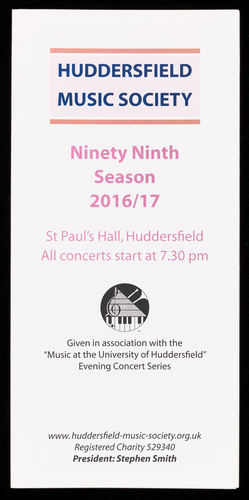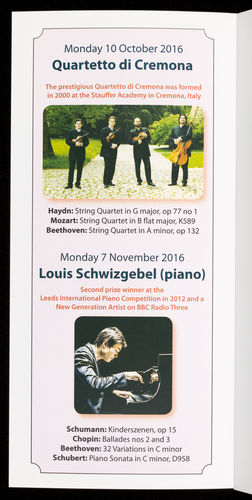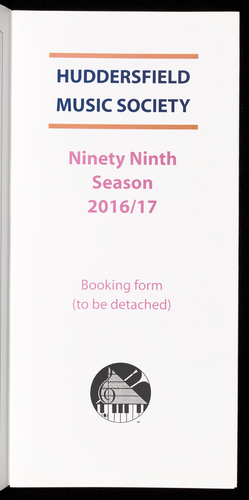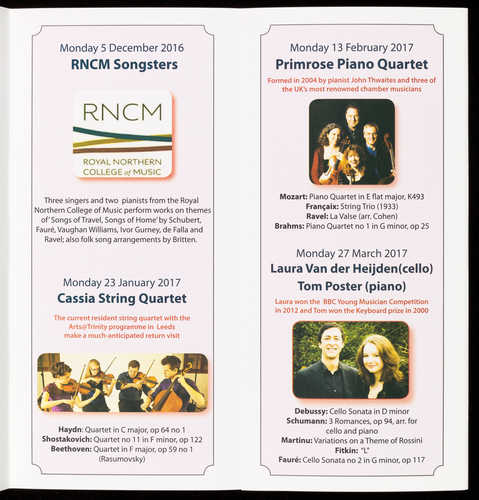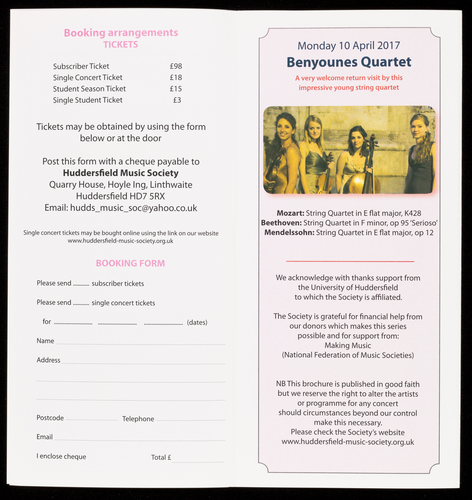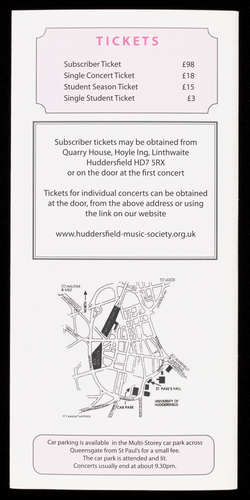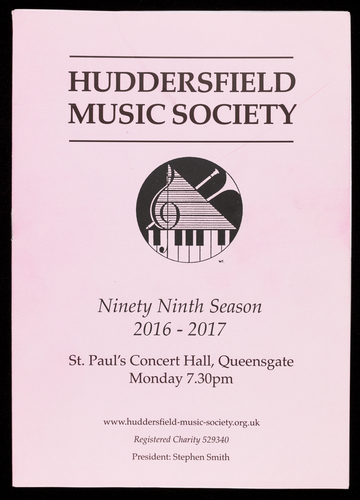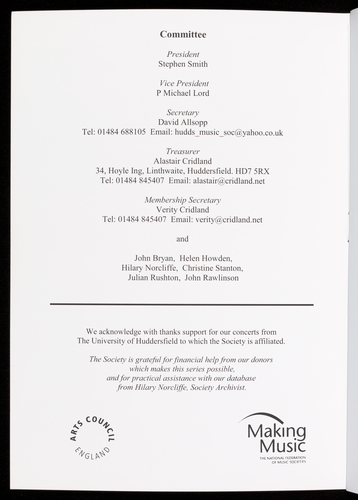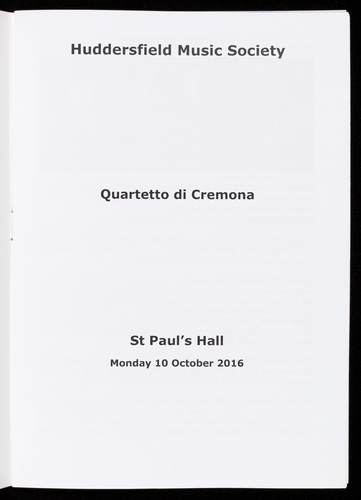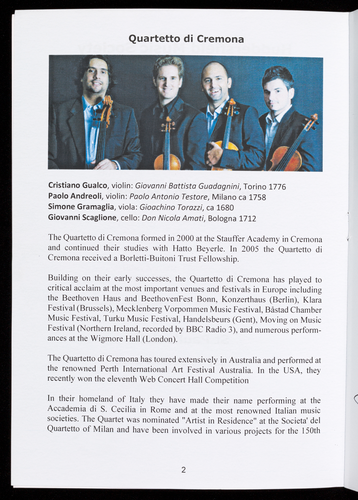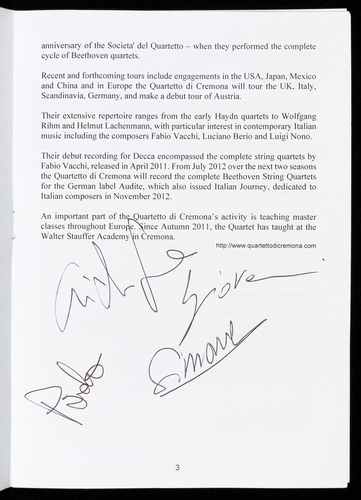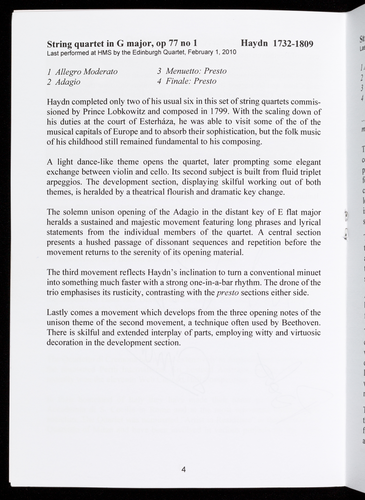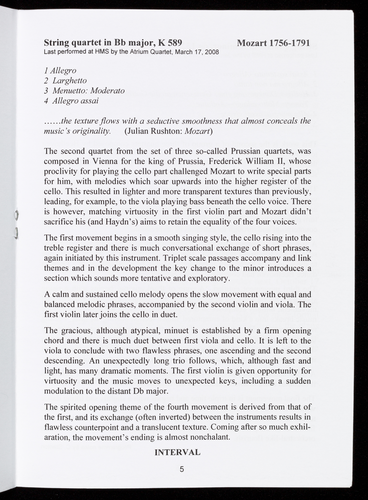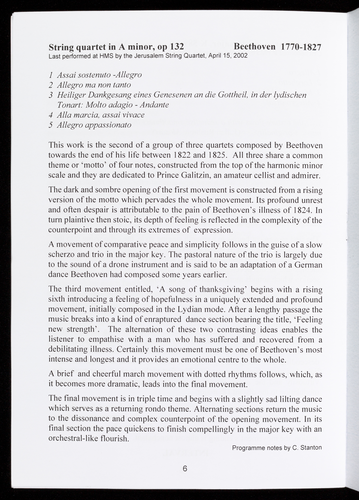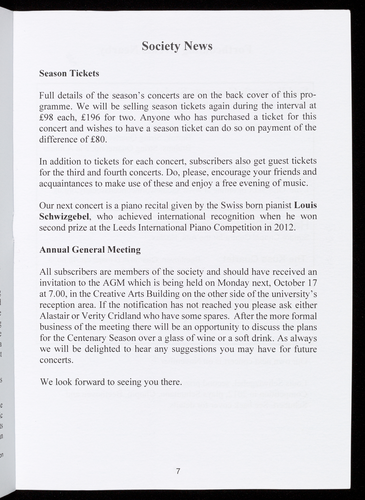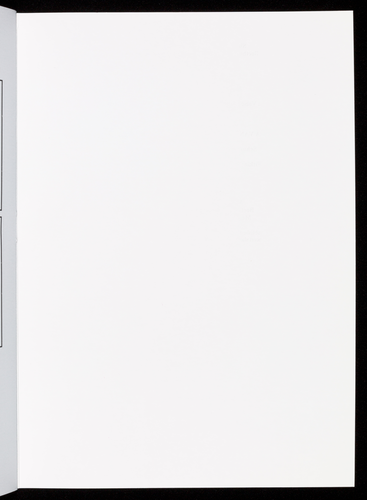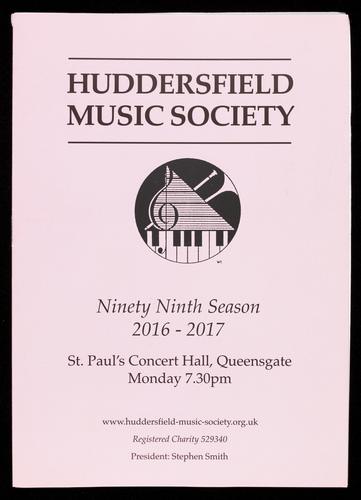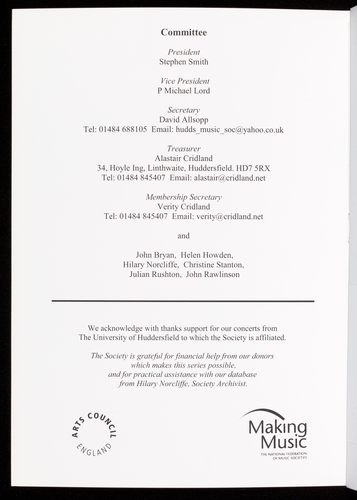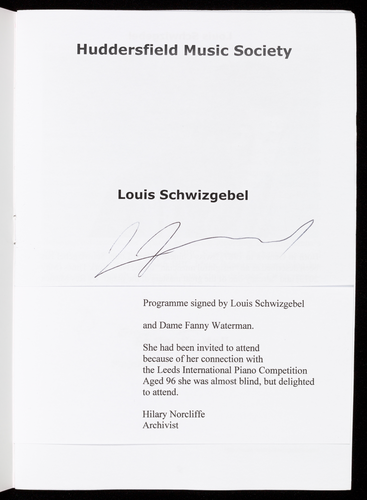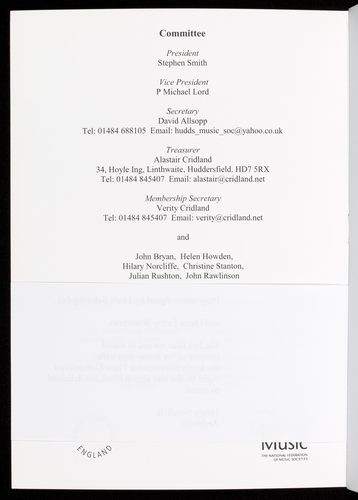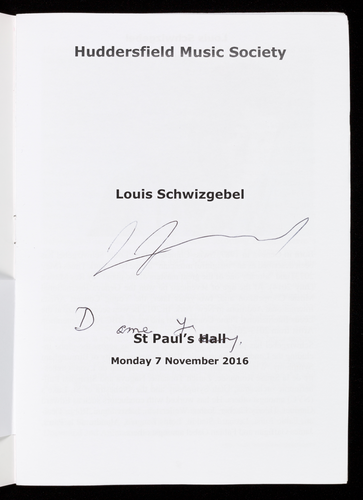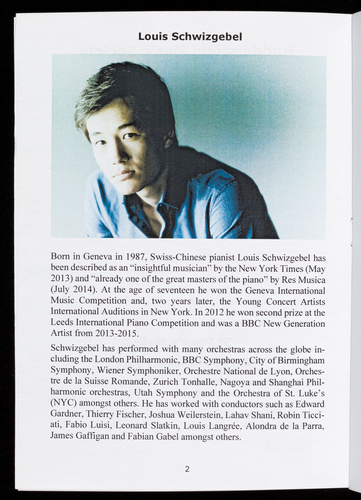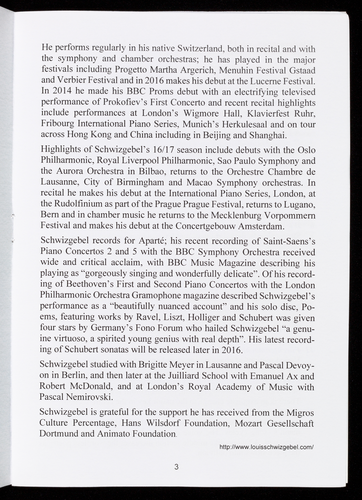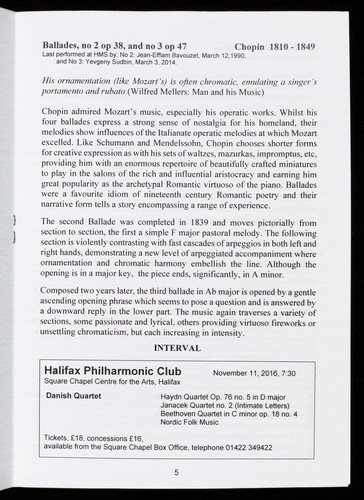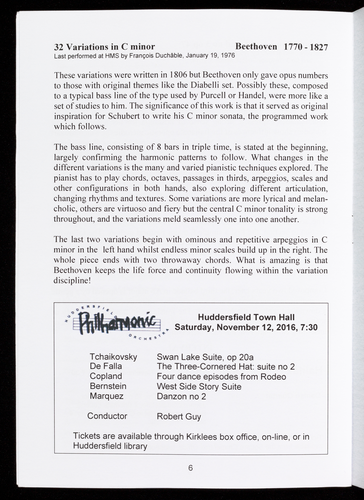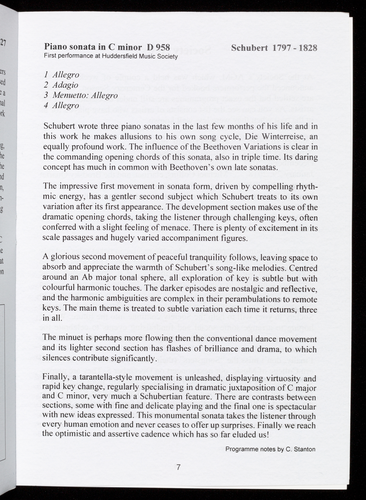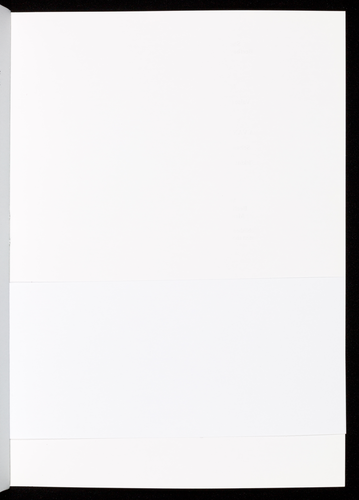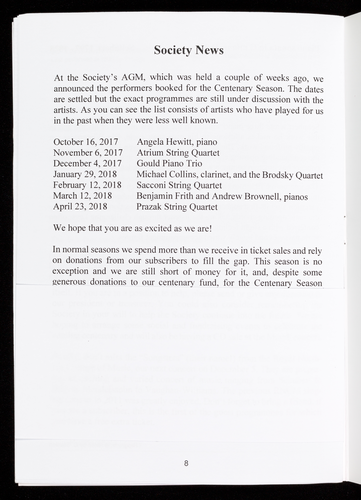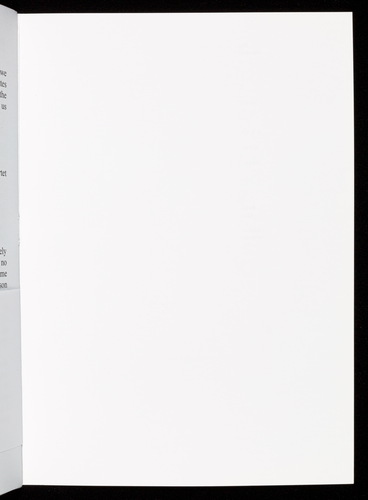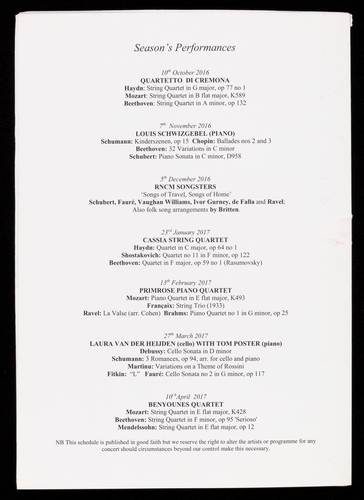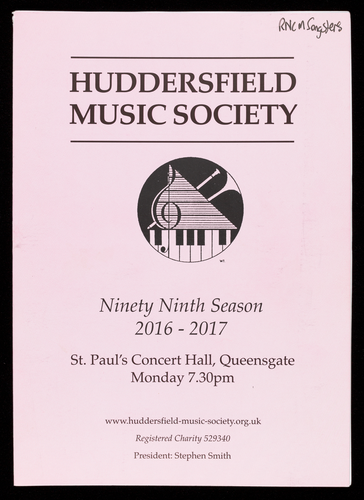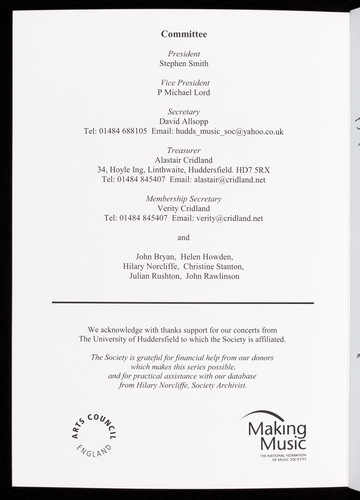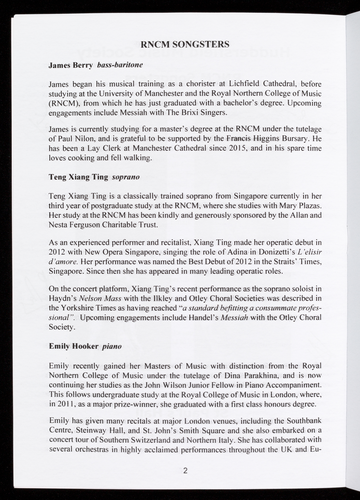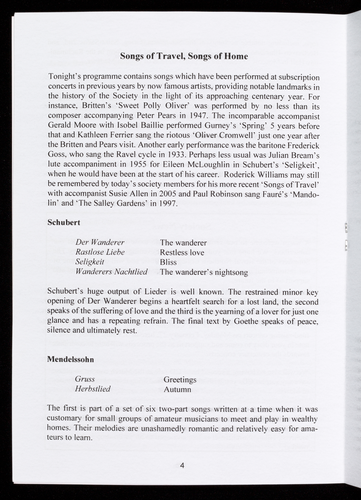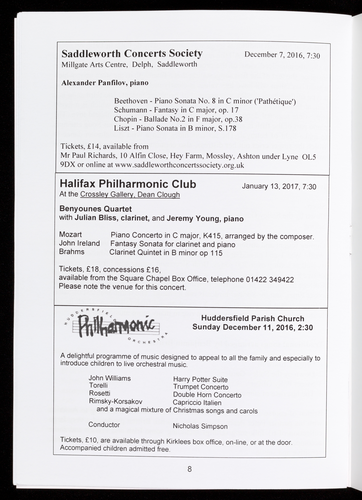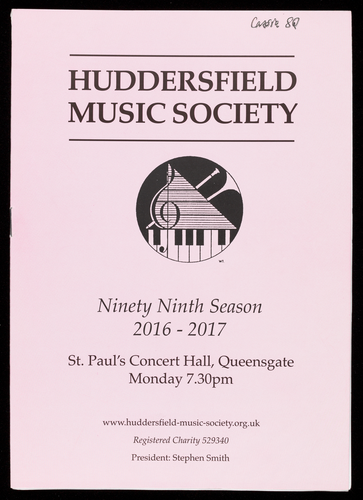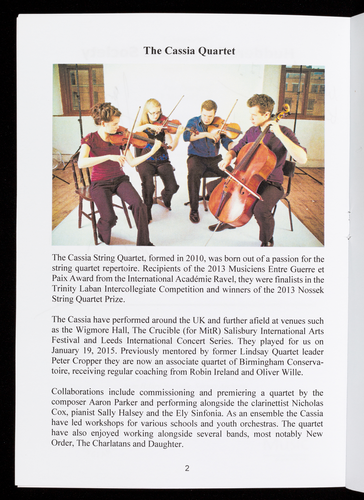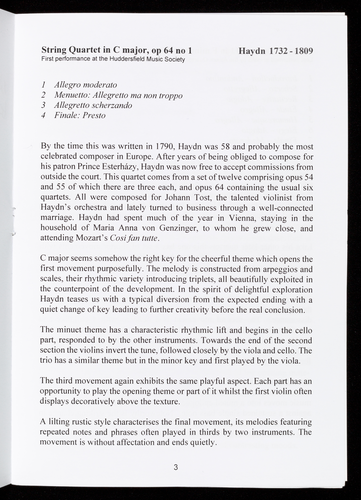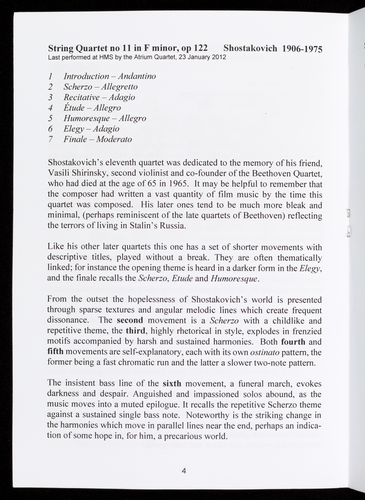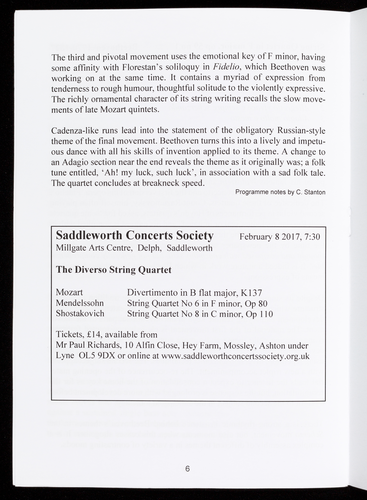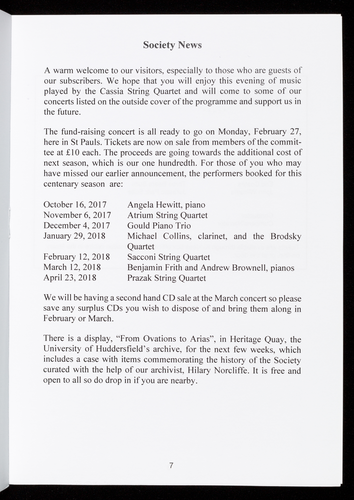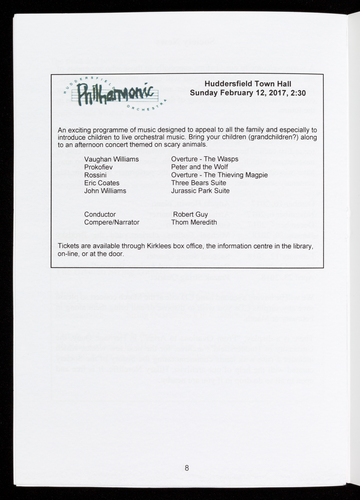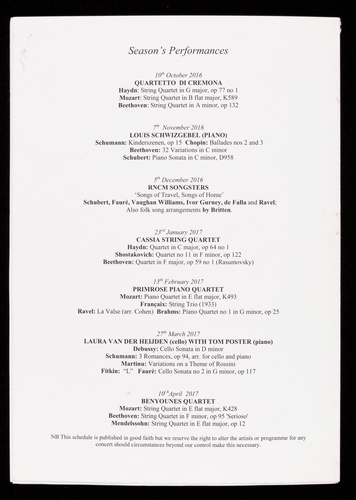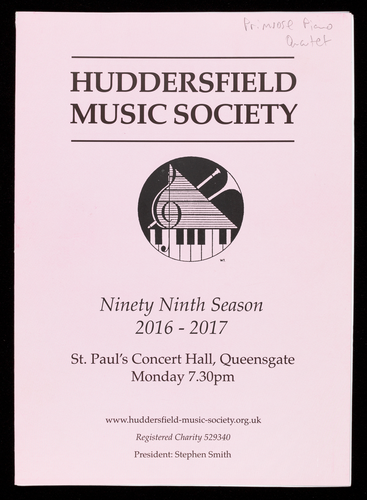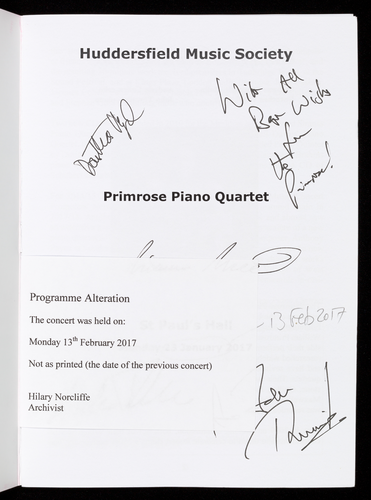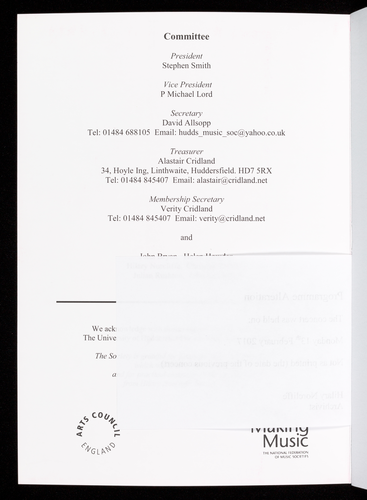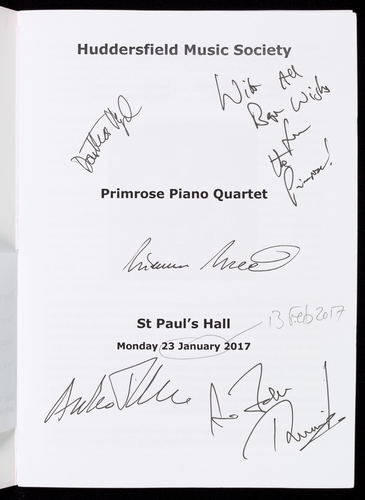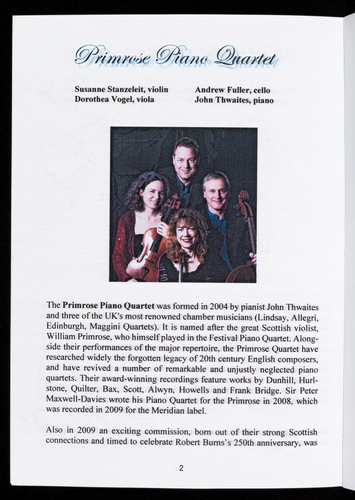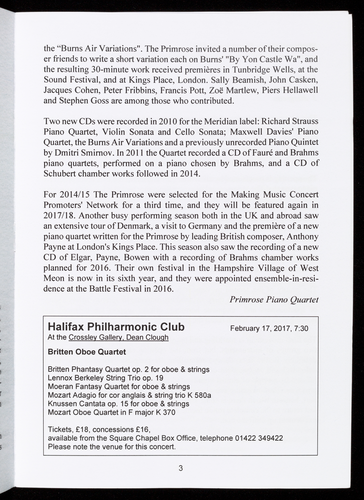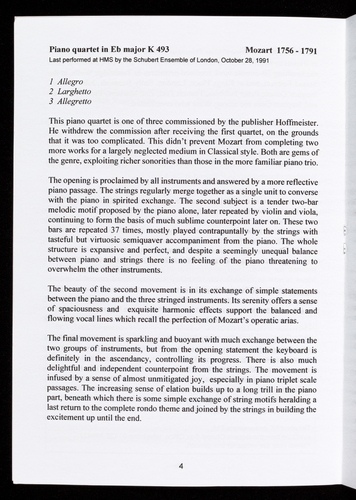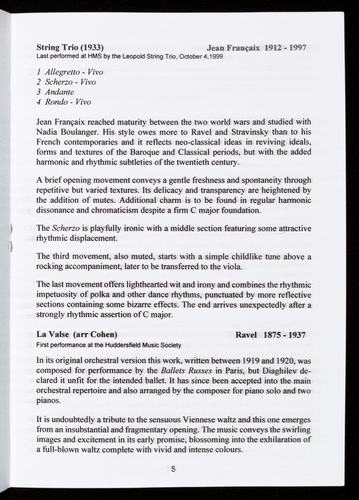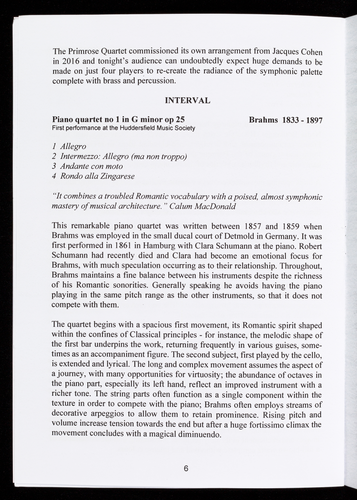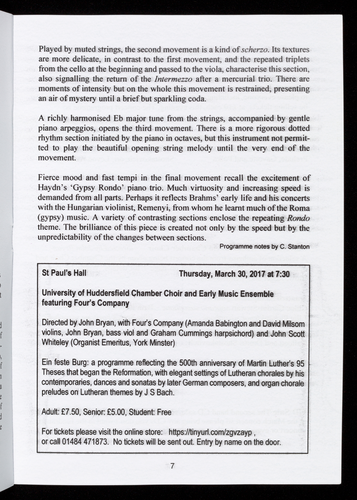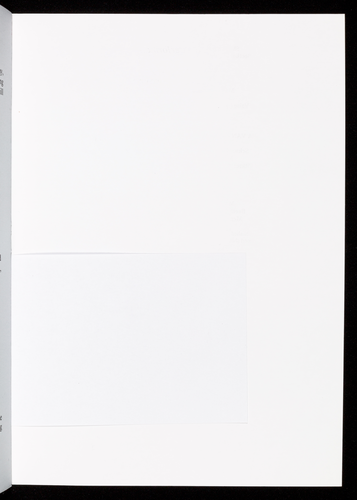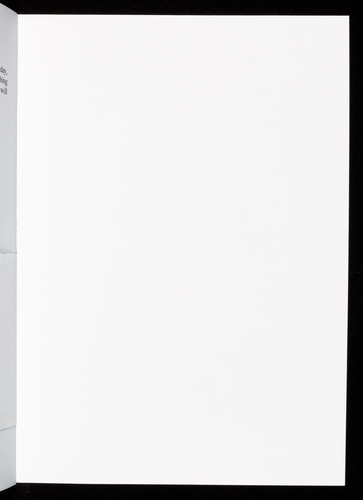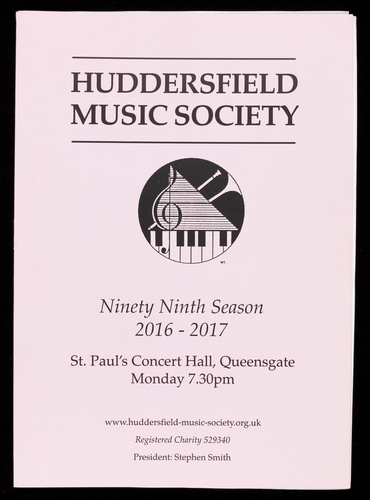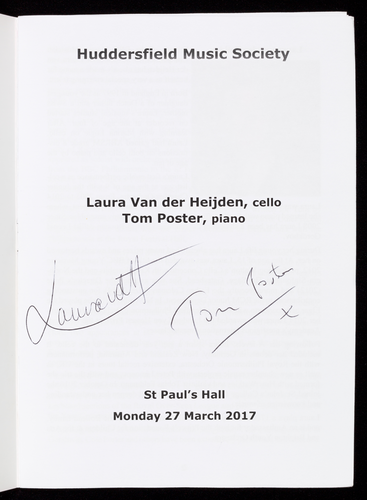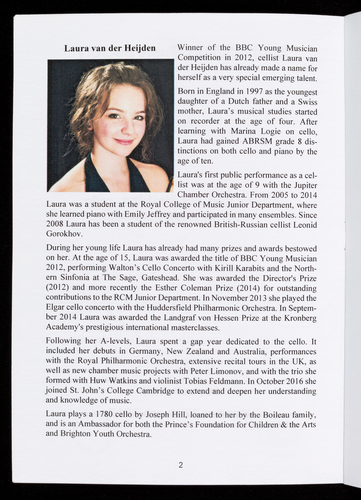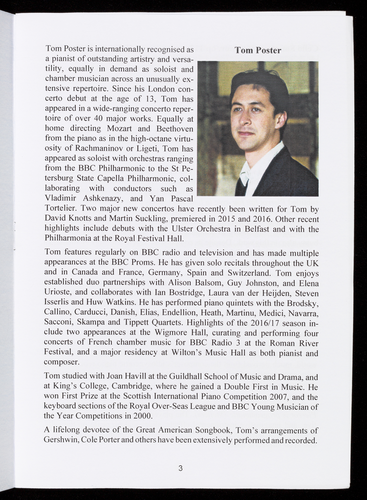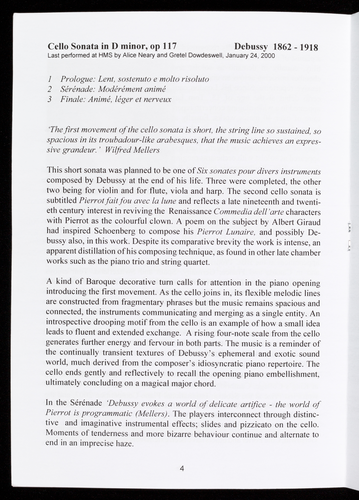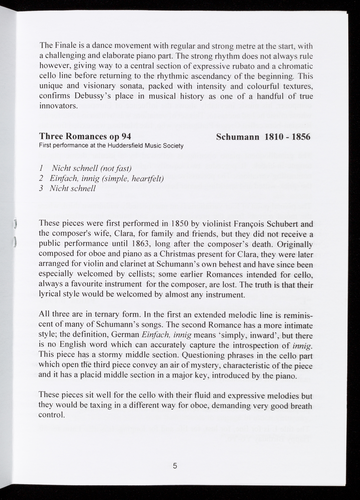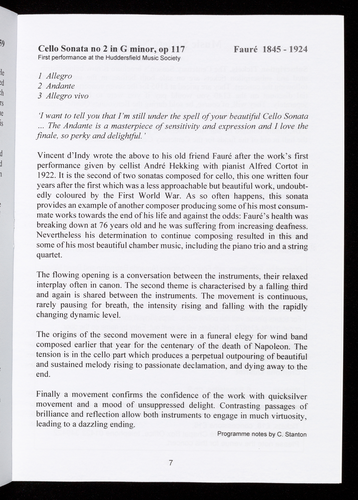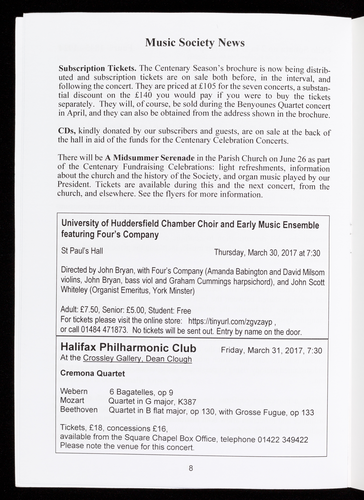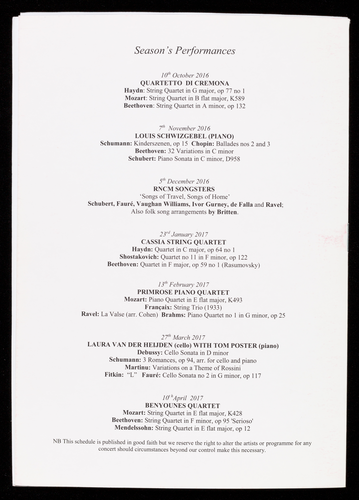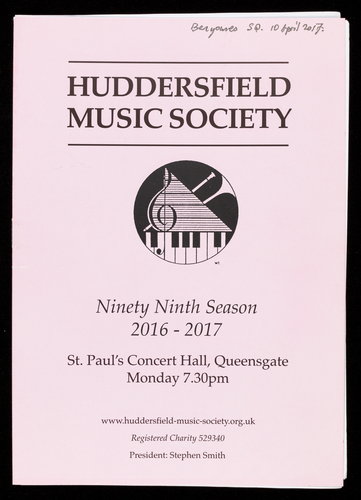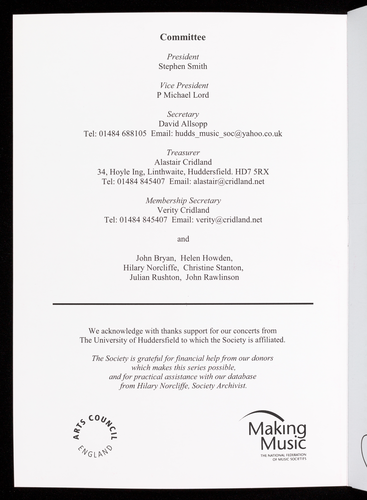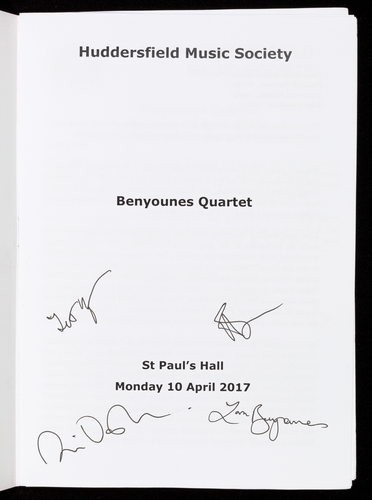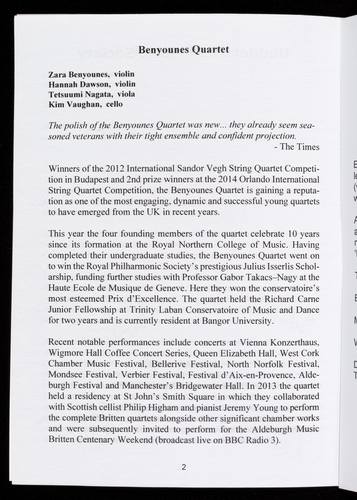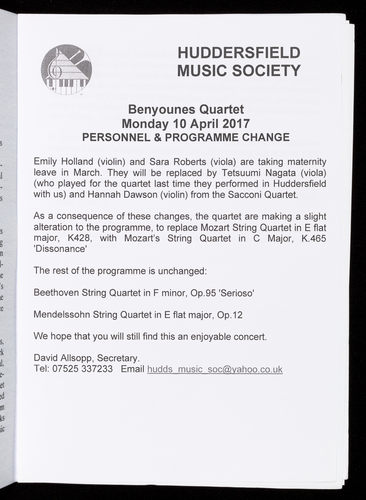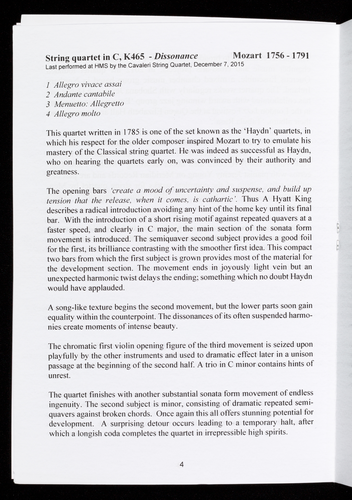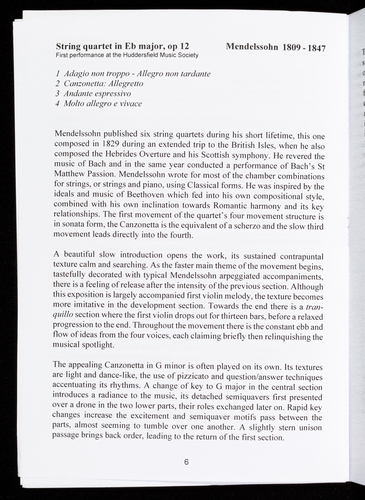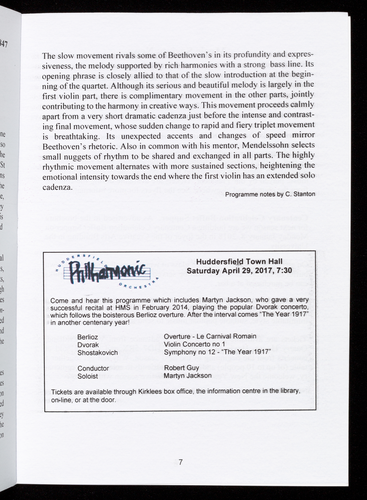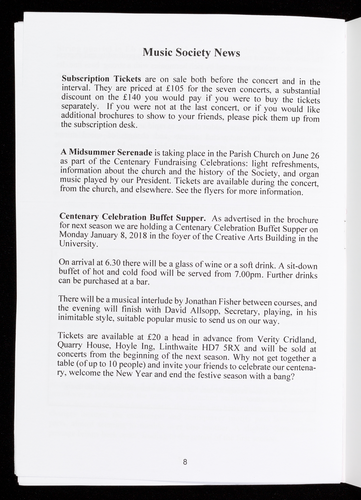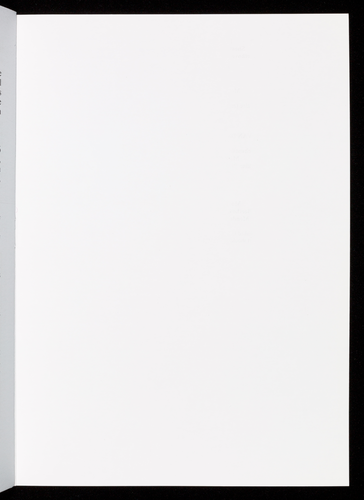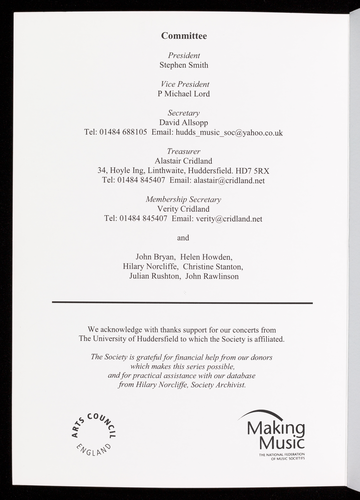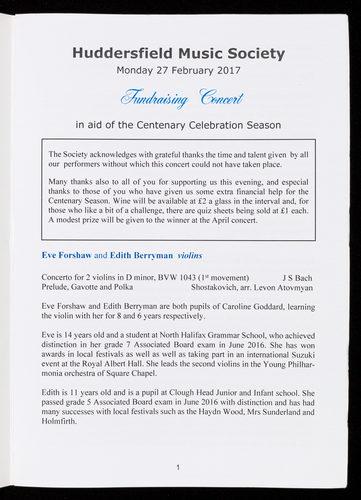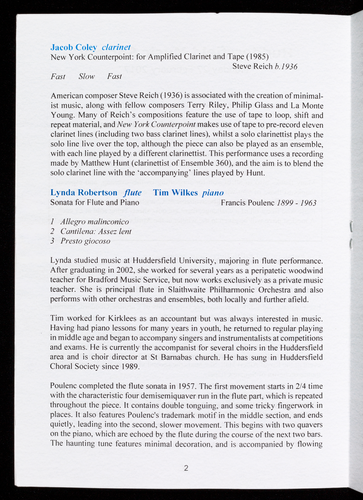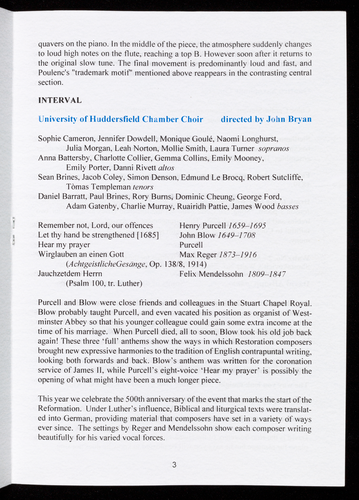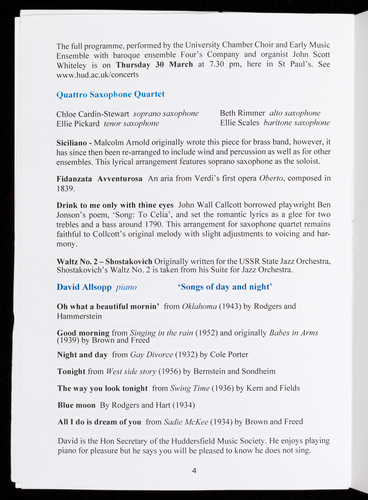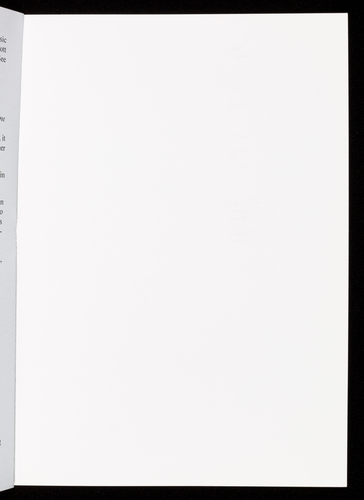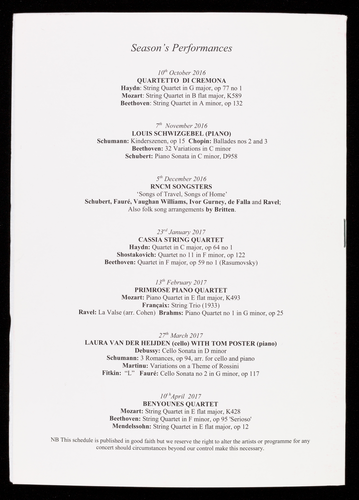Ocr'd Text:
HUDDERSFIELD
MUSIC SOCIETY
Ninety Ninth
Season
2016/17
St Paul's Hall, Huddersfield
All concerts start at 7.30 pm
W1
Given in association with the
"Music at the University of Huddersfield"
Evening Concert Series
www.huddersfield-music-society.org.uk
Registered Charity 529340
President: Stephen Smith
Ste
Ocr'd Text:
Monday 10 October 2016
Quartetto di Cremona
The prestigious Quartetto di Cremona was formed
in 2000 at the Stauffer Academy in Cremona, Italy
Haydn: String Quartet in G major, op 77 no 1
Mozart: String Quartet in B flat major, K589
Beethoven: String Quartet in A minor, op 132
Monday 7 November 2016
Louis Schwizgebel (piano)
Second prize winner at the
Leeds International Piano Competition in 2012 and a
New Generation Artist on BBC Radio Three
2
Schumann: Kinderszenen, op 15
Chopin: Ballades nos 2 and 3
Beethoven: 32 Variations in C minor
Schubert: Piano Sonata in C minor, D958
Ocr'd Text:
HUDDERSFIELD
MUSIC SOCIETY
Ninety Ninth
Season
2016/17
Booking form
(to be detached)
W
WI
Ocr'd Text:
Monday 5 December 2016
RNCM Songsters
RNCM
ROYAL NORTHERN
COLLEGE of MUSIC
Three singers and two pianists from the Royal
Northern College of Music perform works on themes
of' Songs of Travel, Songs of Home' by Schubert,
Fauré, Vaughan Williams, Ivor Gurney, de Falla and
Ravel; also folk song arrangements by Britten.
Monday 23 January 2017
Cassia String Quartet
The current resident string quartet with the
Arts@Trinity programme in Leeds
make a much-anticipated return visit
Haydn: Quartet in C major, op 64 no 1
Shostakovich: Quartet no 11 in F minor, op 122
Beethoven: Quartet in F major, op 59 no 1
(Rasumovsky)
Monday 13 February 2017
Primrose Piano Quartet
Formed in 2004 by pianist John Thwaites and three of
the UK's most renowned chamber musicians
Mozart: Piano Quartet in E flat major, K493
Françaix: String Trio (1933)
Ravel: La Valse (arr. Cohen)
Brahms: Piano Quartet no 1 in G minor, op 25
Monday 27 March 2017
Laura Van der Heijden (cello)
Tom Poster (piano)
Laura won the BBC Young Musician Competition
in 2012 and Tom won the Keyboard prize in 2000
Debussy: Cello Sonata in D minor
Schumann: 3 Romances, op 94, arr. for
cello and piano
Martinu: Variations on a Theme of Rossini
Fitkin: "L"
Fauré: Cello Sonata no 2 in G minor, op 117
Ocr'd Text:
Subscriber Ticket
Single Concert Ticket
Student Season Ticket
Single Student Ticket
Tickets may be obtained by using the form
below or at the door
Post this form with a cheque payable to
Huddersfield Music Society
Quarry House, Hoyle Ing, Linthwaite
Huddersfield HD7 5RX
Email: hudds_music_soc@yahoo.co.uk
for
Booking arrangements
Single concert tickets may be bought online using the link on our website
www.huddersfield-music-society.org.uk
Please send ............ subscriber tickets
Name
Please send ............ single concert tickets
TICKETS
.....
Address
Email
Postcode
...................
BOOKING FORM
I enclose cheque
£98
£18
£15
£3
..........
Telephone
Total £
......
(dates)
Monday 10 April 2017
Benyounes Quartet
A very welcome return visit by this
impressive young string quartet
Mozart: String Quartet in E flat major, K428
Beethoven: String Quartet in F minor, op 95 'Serioso'
Mendelssohn: String Quartet in E flat major, op 12
We acknowledge with thanks support from
the University of Huddersfield
to which the Society is affiliated.
The Society is grateful for financial help from
our donors which makes this series
possible and for support from:
Making Music
(National Federation of Music Societies)
NB This brochure is published in good faith
but we reserve the right to alter the artists
or programme for any concert
should circumstances beyond our control
make this necessary.
Please check the Society's website
www.huddersfield-music-society.org.uk
Ocr'd Text:
Subscriber Ticket
Single Concert Ticket
Student Season Ticket
Single Student Ticket
Subscriber tickets may be obtained from
Quarry House, Hoyle Ing, Linthwaite
Huddersfield HD7 5RX
or on the door at the first concert
Tickets for individual concerts can be obtained
at the door, from the above address or using
the link on our website
TO HAUFAX
A529
www.huddersfield-music-society.org.uk
NEW
TRINITY STREET
TICKETS
NORTH
PP
CASTLE GATE
TO MANY HESTED
A62 MANCHESTER ROAD
400
290 OVEN
1008
00000
300.919
000
QUENT GATE
CAR PARK
LAKET ZAN2
BOURSYA
TO LEEDS
£98
£18
£15
£3
LEEDS ROAD AS2
TO WAKEFIELD
SHEFFIELD
69 WAKEFELD ROAD
ST. PAUL'S HALL
UNIVERSITY OF
HUDDERSFIELD
Car parking is available in the Multi-Storey car park across
Queensgate from St Paul's for a small fee.
The car park is attended and lit.
Concerts usually end at about 9.30pm.
Ocr'd Text:
HUDDERSFIELD
MUSIC SOCIETY
D
IL
WT.
Ninety Ninth Season
2016-2017
St. Paul's Concert Hall, Queensgate
Monday 7.30pm
www.huddersfield-music-society.org.uk
Registered Charity 529340
President: Stephen Smith
Ocr'd Text:
ARTS
Committee
Secretary
David Allsopp
Tel: 01484 688105 Email: hudds_music_soc@yahoo.co.uk
President
Stephen Smith
Vice President
P Michael Lord
Alastair Cridland
34, Hoyle Ing, Linthwaite, Huddersfield. HD7 5RX
Tel: 01484 845407 Email: alastair@cridland.net
Treasurer
Membership Secretary
Verity Cridland
Tel: 01484 845407 Email: verity@cridland.net
COUNCIL
ENGLAND
We acknowledge with thanks support for our concerts from
The University of Huddersfield to which the Society is affiliated.
and
John Bryan, Helen Howden,
Hilary Norcliffe, Christine Stanton,
Julian Rushton, John Rawlinson
The Society is grateful for financial help from our donors
which makes this series possible,
and for practical assistance with our database
from Hilary Norcliffe, Society Archivist.
Making
Music
THE NATIONAL FEDERATION
OF MUSIC SOCIETIES
Ocr'd Text:
Huddersfield Music Society
Quartetto di Cremona
St Paul's Hall
Monday 10 October 2016
Ocr'd Text:
Quartetto di Cremona
SP
BE
Cristiano Gualco, violin: Giovanni Battista Guadagnini, Torino 1776
Paolo Andreoli, violin: Paolo Antonio Testore, Milano ca 1758
Simone Gramaglia, viola: Gioachino Torazzi, ca 1680
Giovanni Scaglione, cello: Don Nicola Amati, Bologna 1712
11
The Quartetto di Cremona formed in 2000 at the Stauffer Academy in Cremonal
and continued their studies with Hatto Beyerle. In 2005 the Quartetto di
Cremona received a Borletti-Buitoni Trust Fellowship.
Building on their early successes, the Quartetto di Cremona has played to
critical acclaim at the most important venues and festivals in Europe including
the Beethoven Haus and BeethovenFest Bonn, Konzerthaus (Berlin), Klara
Festival (Brussels), Mecklenberg Vorpommen Music Festival, Båstad Chamber
Music Festival, Turku Music Festival, Handelsbeurs (Gent), Moving on Music
Festival (Northern Ireland, recorded by BBC Radio 3), and numerous perform-
ances at the Wigmore Hall (London).
The Quartetto di Cremona has toured extensively in Australia and performed at
the renowned Perth International Art Festival Australia. In the USA, they
recently won the eleventh Web Concert Hall Competition
In their homeland of Italy they have made their name performing at the
Accademia di S. Cecilia in Rome and at the most renowned Italian music
societies. The Quartet was nominated "Artist in Residence" at the Societa' del
Quartetto of Milan and have been involved in various projects for the 150th
2
Ocr'd Text:
anniversary of the Societa' del Quartetto - when they performed the complete
cycle of Beethoven quartets.
Recent and forthcoming tours include engagements in the USA, Japan, Mexico
and China and in Europe the Quartetto di Cremona will tour the UK, Italy,
Scandinavia, Germany, and make a debut tour of Austria.
Their extensive repertoire ranges from the early Haydn quartets to Wolfgang
Rihm and Helmut Lachenmann, with particular interest in contemporary Italian
music including the composers Fabio Vacchi, Luciano Berio and Luigi Nono.
Their debut recording for Decca encompassed the complete string quartets by
Fabio Vacchi, released in April 2011. From July 2012 over the next two seasons
the Quartetto di Cremona will record the complete Beethoven String Quartets.
for the German label Audite, which also issued Italian Journey, dedicated to
Italian composers in November 2012.
An important part of the Quartetto di Cremona's activity is teaching master
classes throughout Europe. Since Autumn 2011, the Quartet has taught at the
Walter Stauffer Academy in Cremona.
and pr
Giove
Smove
J
3
http://www.quartettodicremona.com
Ocr'd Text:
String quartet in G major, op 77 no 1
Last performed at HMS by the Edinburgh Quartet, February 1, 2010
1 Allegro Moderato
2 Adagio
3 Menuetto: Presto
4 Finale: Presto
Haydn 1732-1809
Haydn completed only two of his usual six in this set of string quartets commis-
sioned by Prince Lobkowitz and composed in 1799. With the scaling down of
his duties at the court of Esterháza, he was able to visit some of the of the
musical capitals of Europe and to absorb their sophistication, but the folk music
of his childhood still remained fundamental to his composing.
A light dance-like theme opens the quartet, later prompting some elegant
exchange between violin and cello. Its second subject is built from fluid triplet
arpeggios. The development section, displaying skilful working out of both
themes, is heralded by a theatrical flourish and dramatic key change.
The solemn unison opening of the Adagio in the distant key of E flat major
heralds a sustained and majestic movement featuring long phrases and lyrical
statements from the individual members of the quartet. A central section
presents a hushed passage of dissonant sequences and repetition before the
movement returns to the serenity of its opening material.
The third movement reflects Haydn's inclination to turn a conventional minuet
into something much faster with a strong one-in-a-bar rhythm. The drone of the
trio emphasises its rusticity, contrasting with the presto sections either side.
Lastly comes a movement which develops from the three opening notes of the
unison theme of the second movement, a technique often used by Beethoven.
There is skilful and extended interplay of parts, employing witty and virtuosic
decoration in the development section.
4
Str
Las
12
2
3
4
m
T
CO
p
fo
C
le
19
S
C
r
t
f
a
Ocr'd Text:
Ĵ
J
String quartet in Bb major, K 589
Last performed at HMS by the Atrium Quartet, March 17, 2008
1 Allegro
2 Larghetto
3 Menuetto: Moderato
4 Allegro assai
Mozart 1756-1791
......the texture flows with a seductive smoothness that almost conceals the
music's originality. (Julian Rushton: Mozart)
The second quartet from the set of three so-called Prussian quartets, was
composed in Vienna for the king of Prussia, Frederick William II, whose
proclivity for playing the cello part challenged Mozart to write special parts
for him, with melodies which soar upwards into the higher register of the
cello. This resulted in lighter and more transparent textures than previously,
leading, for example, to the viola playing bass beneath the cello voice. There
is however, matching virtuosity in the first violin part and Mozart didn't
sacrifice his (and Haydn's) aims to retain the equality of the four voices.
The first movement begins in a smooth singing style, the cello rising into the
treble register and there is much conversational exchange of short phrases,
again initiated by this instrument. Triplet scale passages accompany and link
themes and in the development the key change to the minor introduces a
section which sounds more tentative and exploratory.
A calm and sustained cello melody opens the slow movement with equal and
balanced melodic phrases, accompanied by the second violin and viola. The
first violin later joins the cello in duet.
The gracious, although atypical, minuet is established by a firm opening
chord and there is much duet between first viola and cello. It is left to the
viola to conclude with two flawless phrases, one ascending and the second
descending. An unexpectedly long trio follows, which, although fast and
light, has many dramatic moments. The first violin is given opportunity for
virtuosity and the music moves to unexpected keys, including a sudden
modulation to the distant Db major.
The spirited opening theme of the fourth movement is derived from that of
the first, and its exchange (often inverted) between the instruments results in
flawless counterpoint and a translucent texture. Coming after so much exhil-
aration, the movement's ending is almost nonchalant.
INTERVAL
5
Ocr'd Text:
String quartet in A minor, op 132
Last performed at HMS by the Jerusalem String Quartet, April 15, 2002
Beethoven 1770-1827
1 Assai sostenuto -Allegro
2 Allegro ma non tanto
3 Heiliger Dankgesang eines Genesenen an die Gottheil, in der lydischen
Tonart: Molto adagio - Andante
4 Alla marcia, assai vivace
5 Allegro appassionato
This work is the second of a group of three quartets composed by Beethoven
towards the end of his life between 1822 and 1825. All three share a common
theme or 'motto' of four notes, constructed from the top of the harmonic minor
scale and they are dedicated to Prince Galitzin, an amateur cellist and admirer.
The dark and sombre opening of the first movement is constructed from a rising
version of the motto which pervades the whole movement. Its profound unrest
and often despair is attributable to the pain of Beethoven's illness of 1824. In
turn plaintive then stoic, its depth of feeling is reflected in the complexity of the
counterpoint and through its extremes of expression.
A movement of comparative peace and simplicity follows in the guise of a slow
scherzo and trio in the major key. The pastoral nature of the trio is largely due
to the sound of a drone instrument and is said to be an adaptation of a German
dance Beethoven had composed some years earlier.
The third movement entitled, 'A song of thanksgiving' begins with a rising
sixth introducing a feeling of hopefulness in a uniquely extended and profound
movement, initially composed in the Lydian mode. After a lengthy passage the
music breaks into a kind of enraptured dance section bearing the title, 'Feeling
new strength'. The alternation of these two contrasting ideas enables the
listener to empathise with a man who has suffered and recovered from a
debilitating illness. Certainly this movement must be one of Beethoven's most
intense and longest and it provides an emotional centre to the whole.
A brief and cheerful march movement with dotted rhythms follows, which, as
it becomes more dramatic, leads into the final movement.
The final movement is in triple time and begins with a slightly sad lilting dance
which serves as a returning rondo theme. Alternating sections return the music
to the dissonance and complex counterpoint of the opening movement. In its
final section the pace quickens to finish compellingly in the major key with an
orchestral-like flourish.
Programme notes by C. Stanton
6
Ocr'd Text:
1
e
e
3.
t
S
e
IC
ts
in
on
Season Tickets
Society News
Full details of the season's concerts are on the back cover of this pro-
gramme. We will be selling season tickets again during the interval at
£98 each, £196 for two. Anyone who has purchased a ticket for this
concert and wishes to have a season ticket can do so on payment of the
difference of £80.
In addition to tickets for each concert, subscribers also get guest tickets
for the third and fourth concerts. Do, please, encourage your friends and
acquaintances to make use of these and enjoy a free evening of music.
Our next concert is a piano recital given by the Swiss born pianist Louis
Schwizgebel, who achieved international recognition when he won
second prize at the Leeds International Piano Competition in 2012.
Annual General Meeting
All subscribers are members of the society and should have received an
invitation to the AGM which is being held on Monday next, October 17
at 7.00, in the Creative Arts Building on the other side of the university's
reception area. If the notification has not reached you please ask either
Alastair or Verity Cridland who have some spares. After the more formal
business of the meeting there will be an opportunity to discuss the plans
for the Centenary Season over a glass of wine or a soft drink. As always
we will be delighted to hear any suggestions you may have for future
concerts.
We look forward to seeing you there.
7
Ocr'd Text:
Forthcoming Events Nearby
Saddleworth Concerts Society
Millgate Arts Centre, Delph, Saddleworth
The Elias String Quartet
Haydn: String Quartet in D op.76 no.5
Bartok: String Quartet no. 4
Brahms: String Quartet no. 2 in A minor
Halifax Philharmonic Club
Square Chapel Centre for the Arts, Halifax
The Kuss Quartet
m
Tickets, £14, available from
Mr Paul Richards, 10 Alfin Close, Hey Farm, Mossley, Ashton under
Lyne OL5 9DX or online at www.saddleworthconcertssociety.org.uk
October 12, 2016, 7:30
Our own next concert is on November 7:
Beethoven: Quartet in D major op. 18 no. 3
Kurtág: Officium breve
Brahms: Quartet no. 3 in B flat major op. 67
October 21, 2016, 7:30
Tickets, £18, concessions £16,
available from the Square Chapel Box Office, telephone 01422 349422
8
Louis Schwizgebel, second prize winner of the Leeds International
Competition in 2012, plays Schumann, Chopin, Beethoven and
Schubert. See back cover for details.
Ocr'd Text:
Season's Performances
10th October 2016
QUARTETTO DI CREMONA
Haydn: String Quartet in G major, op 77 no 1
Mozart: String Quartet in B flat major, K589
Beethoven: String Quartet in A minor, op 132
7th November 2016
LOUIS SCHWIZGEBEL (PIANO)
Schumann: Kinderszenen, op 15 Chopin: Ballades nos 2 and 3
Beethoven: 32 Variations in C minor
Schubert: Piano Sonata in C minor, D958
5th December 2016
RNCM SONGSTERS
'Songs of Travel, Songs of Home'
Schubert, Fauré, Vaughan Williams, Ivor Gurney, de Falla and Ravel;
Also folk song arrangements by Britten.
23rd January 2017
CASSIA STRING QUARTET
Haydn: Quartet in C major, op 64 no 1
Shostakovich: Quartet no 11 in F minor, op 122
Beethoven: Quartet in F major, op 59 no 1 (Rasumovsky)
13th February 2017
PRIMROSE PIANO QUARTET
Mozart: Piano Quartet in E flat major, K493
Françaix: String Trio (1933)
Ravel: La Valse (arr. Cohen) Brahms: Piano Quartet no 1 in G minor, op 25
27th March 2017
LAURA VAN DER HEIJDEN (cello) WITH TOM POSTER (piano)
Debussy: Cello Sonata in D minor
Schumann: 3 Romances, op 94, arr. for cello and piano
Martinu: Variations on a Theme of Rossini
Fitkin: "L" Fauré: Cello Sonata no 2 in G minor, op 117
10th April 2017
BENYOUNES QUARTET
Mozart: String Quartet in E flat major, K428
Beethoven: String Quartet in F minor, op 95 'Serioso'
Mendelssohn: String Quartet in E flat major, op 12
NB This schedule is published in good faith but we reserve the right to alter the artists or programme for any
concert should circumstances beyond our control make this necessary.
Ocr'd Text:
HUDDERSFIELD
MUSIC SOCIETY
LL
WT.
Ninety Ninth Season
2016-2017
St. Paul's Concert Hall, Queensgate
Monday 7.30pm
www.huddersfield-music-society.org.uk
Registered Charity 529340
President: Stephen Smith
Ocr'd Text:
ARTS
Committee
Secretary
David Allsopp
Tel: 01484 688105 Email: hudds_music_soc@yahoo.co.uk
President
Stephen Smith
Vice President
P Michael Lord
Alastair Cridland
34, Hoyle Ing, Linthwaite, Huddersfield. HD7 5RX
Tel: 01484 845407 Email: alastair@cridland.net
Treasurer
Membership Secretary
Verity Cridland
Tel: 01484 845407 Email: verity@cridland.net
COUNCIL
ENGLAND
We acknowledge with thanks support for our concerts from
The University of Huddersfield to which the Society is affiliated.
and
John Bryan, Helen Howden,
Hilary Norcliffe, Christine Stanton,
Julian Rushton, John Rawlinson
The Society is grateful for financial help from our donors
which makes this series possible,
and for practical assistance with our database
from Hilary Norcliffe, Society Archivist.
Making
Music
THE NATIONAL FEDERATION
OF MUSIC SOCIETIES
Ocr'd Text:
Huddersfield Music Society
Louis Schwizgebel
27
Programme signed by Louis Schwizgebel
and Dame Fanny Waterman.
She had been invited to attend
because of her connection with
the Leeds International Piano Competition
Aged 96 she was almost blind, but delighted
to attend.
Hilary Norcliffe
Archivist
Ocr'd Text:
no
Committee
President
Stephen Smith
Vice President
P Michael Lord
Secretary
David Allsopp
Tel: 01484 688105 Email: hudds_music_soc@yahoo.co.uk
ENGLAND
Treasurer
Alastair Cridland
34, Hoyle Ing, Linthwaite, Huddersfield. HD7 5RX
Tel: 01484 845407 Email: alastair@cridland.net
Membership Secretary
Verity Cridland
Tel: 01484 845407 Email: verity@cridland.net
and
John Bryan, Helen Howden,
Hilary Norcliffe, Christine Stanton,
Julian Rushton, John Rawlinson
IVIUSIC
THE NATIONAL FEDERATION
OF MUSIC SOCIETIES
Ocr'd Text:
Huddersfield Music Society
D
Louis Schwizgebel
nowe
ROUTE
RASM
y
St Paul's Hally,
Monday 7 November 2016
ame
Q
Ocr'd Text:
Louis Schwizgebel
Born in Geneva in 1987, Swiss-Chinese pianist Louis Schwizgebel has
been described as an "insightful musician" by the New York Times (May
2013) and "already one of the great masters of the piano" by Res Musical
(July 2014). At the age of seventeen he won the Geneva International
Music Competition and, two years later, the Young Concert Artists
International Auditions in New York. In 2012 he won second prize at the
Leeds International Piano Competition and was a BBC New Generation
Artist from 2013-2015.
Schwizgebel has performed with many orchestras across the globe in-
cluding the London Philharmonic, BBC Symphony, City of Birmingham
Symphony, Wiener Symphoniker, Orchestre National de Lyon, Orches-
tre de la Suisse Romande, Zurich Tonhalle, Nagoya and Shanghai Phil-
harmonic orchestras, Utah Symphony and the Orchestra of St. Luke's
(NYC) amongst others. He has worked with conductors such as Edward
Gardner, Thierry Fischer, Joshua Weilerstein, Lahav Shani, Robin Ticci-
ati, Fabio Luisi, Leonard Slatkin, Louis Langrée, Alondra de la Parra,
James Gaffigan and Fabian Gabel amongst others.
2
Ocr'd Text:
He performs regularly in his native Switzerland, both in recital and with
the symphony and chamber orchestras; he has played in the major
festivals including Progetto Martha Argerich, Menuhin Festival Gstaad
and Verbier Festival and in 2016 makes his debut at the Lucerne Festival.
In 2014 he made his BBC Proms debut with an electrifying televised
performance of Prokofiev's First Concerto and recent recital highlights
include performances at London's Wigmore Hall, Klavierfest Ruhr,
Fribourg International Piano Series, Munich's Herkulesaal and on tour
across Hong Kong and China including in Beijing and Shanghai.
Highlights of Schwizgebel's 16/17 season include debuts with the Oslo
Philharmonic, Royal Liverpool Philharmonic, Sao Paulo Symphony and
the Aurora Orchestra in Bilbao, returns to the Orchestre Chambre de
Lausanne, City of Birmingham and Macao Symphony orchestras. In
recital he makes his debut at the International Piano Series, London, at
the Rudolfinium as part of the Prague Prague Festival, returns to Lugano,
Bern and in chamber music he returns to the Mecklenburg Vorpommern
Festival and makes his debut at the Concertgebouw Amsterdam.
Schwizgebel records for Aparté; his recent recording of Saint-Saens's
Piano Concertos 2 and 5 with the BBC Symphony Orchestra received
wide and critical acclaim, with BBC Music Magazine describing his
playing as "gorgeously singing and wonderfully delicate". Of his record-
ing of Beethoven's First and Second Piano Concertos with the London
Philharmonic Orchestra Gramophone magazine described Schwizgebel's
performance as a "beautifully nuanced account" and his solo disc, Po-
ems, featuring works by Ravel, Liszt, Holliger and Schubert was given
four stars by Germany's Fono Forum who hailed Schwizgebel "a genu-
ine virtuoso, a spirited young genius with real depth". His latest record-
ing of Schubert sonatas will be released later in 2016.
Schwizgebel studied with Brigitte Meyer in Lausanne and Pascal Devoy-
on in Berlin, and then later at the Juilliard School with Emanuel Ax and
Robert McDonald, and at London's Royal Academy of Music with
Pascal Nemirovski.
Schwizgebel is grateful for the support he has received from the Migros
Culture Percentage, Hans Wilsdorf Foundation, Mozart Gesellschaft
Dortmund and Animato Foundation.
3
http://www.louisschwizgebel.com/
Ocr'd Text:
Kinderszenen, op 15
Last performed at HMS by Paul Lewis, October 6, 2003
This set of simple expressive pieces is designed to recall memories of child-
hood. Schumann's simple textures communicate the emotions directly. Each
piece is in simple 2 or 3 part form.
Schumann 1810 - 1856
1 Von fremden Ländern und Menschen - From foreign lands and people
The gentle repetitive melody is accompanied by lilting triplets
2 Kuriose Geschichte - Funny story
A cautious revelation with a shift to the minor key
3 Hasche-Mann - Blind man's buff
This scampering piece re-captures the excitement in its unexpected accents
4 Bittendes Kind - Pleading child
Beginning in the higher register of the piano, this piece is gentle, unhurried
and seems to end with a query
5 Glückes genug - Perfect happiness
Small sections of right hand melody are often echoed by the left in this
cheerful and relaxed piece
6 Wichtige Begebenheit - A great event
Strong chords, dotted rhythms and left hand octaves recall pomp and
ceremony
7 Träumerei - Dreams
Spread chords enhance the dream-like quality - counterpoint beneath the
melody and the odd harmonic twist add colour
8 Am Kamin - At the fireside
A piece exuding warmth through its rich chords and melodic shapes
Ritter vom Steckenpferd - Ride a cock horse
Syncopated rhythms in the right hand illustrate the movement of the horse
10 Fast zu ernst - Almost too serious
Flowing and in a very remote key, much in Schumann's fantasy style
11 Fürchtenmachen - Bogeyman's coming
Varied sections of changing speed and unexpected chromatic notes lend
this movement a feeling of unpredictability
12 Kind im Einschlummern - Baby going to sleep
Self evident in its rocking rhythm, the sleep motif is often heard in canon.
There is an exquisite change to the major key in the centre section.
13 Der Dichter spricht - The poet speaks
A beautifully crafted postlude sums up the work in the manner of Schu
mann's song cycles. The voice ceases and the melody sings on in the
piano part. A fantasy-like middle section increases the wordless poetry as
the piece slows into oblivion.
4
Ocr'd Text:
}
1
Ballades, no 2 op 38, and no 3 op 47
Last performed at HMS by: No 2: Jean-Efflam Bavouzet, March 12,1990,
and No 3: Yevgeny Sudbin, March 3, 2014.
His ornamentation (like Mozart's) is often chromatic, emulating a singer's
portamento and rubato (Wilfred Mellers: Man and his Music)
Chopin 1810-1849
Chopin admired Mozart's music, especially his operatic works. Whilst his
four ballades express a strong sense of nostalgia for his homeland, their
melodies show influences of the Italianate operatic melodies at which Mozart
excelled. Like Schumann and Mendelssohn, Chopin chooses shorter forms
for creative expression as with his sets of waltzes, mazurkas, impromptus, etc,
providing him with an enormous repertoire of beautifully crafted miniatures
to play in the salons of the rich and influential aristocracy and earning him
great popularity as the archetypal Romantic virtuoso of the piano. Ballades
were a favourite idiom of nineteenth century Romantic poetry and their
narrative form tells a story encompassing a range of experience.
The second Ballade was completed in 1839 and moves pictorially from
section to section, the first a simple F major pastoral melody. The following
section is violently contrasting with fast cascades of arpeggios in both left and
right hands, demonstrating a new level of arpeggiated accompaniment where
ornamentation and chromatic harmony embellish the line. Although the
opening is in a major key, the piece ends, significantly, in A minor.
Composed two years later, the third ballade in Ab major is opened by a gentle
ascending opening phrase which seems to pose a question and is answered by
a downward reply in the lower part. The music again traverses a variety of
sections, some passionate and lyrical, others providing virtuoso fireworks or
unsettling chromaticism, but each increasing in intensity.
INTERVAL
Halifax Philharmonic Club
Square Chapel Centre for the Arts, Halifax
Danish Quartet
November 11, 2016, 7:30
Haydn Quartet Op. 76 no. 5 in D major
Janacek Quartet no. 2 (Intimate Letters)
Beethoven Quartet in C minor op. 18 no. 4
Nordic Folk Music
5
Tickets, £18, concessions £16,
available from the Square Chapel Box Office, telephone 01422 349422
Ocr'd Text:
32 Variations in C minor
Last performed at HMS by François Duchâble, January 19, 1976
These variations were written in 1806 but Beethoven only gave opus numbers
to those with original themes like the Diabelli set. Possibly these, composed
to a typical bass line of the type used by Purcell or Handel, were more like a
set of studies to him. The significance of this work is that it served as original
inspiration for Schubert to write his C minor sonata, the programmed work
which follows.
The bass line, consisting of 8 bars in triple time, is stated at the beginning,
largely confirming the harmonic patterns to follow. What changes in the
different variations is the many and varied pianistic techniques explored. The
pianist has to play chords, octaves, passages in thirds, arpeggios, scales and
other configurations in both hands, also exploring different articulation,
changing rhythms and textures. Some variations are more lyrical and melan-
cholic, others are virtuoso and fiery but the central C minor tonality is strong
throughout, and the variations meld seamlessly one into one another.
Beethoven 1770-1827
The last two variations begin with ominous and repetitive arpeggios in C
minor in the left hand whilst endless minor scales build up in the right. The
whole piece ends with two throwaway chords. What is amazing is that
Beethoven keeps the life force and continuity flowing within the variation
discipline!
Philharmonic
ORCHEST
Huddersfield Town Hall
Saturday, November 12, 2016, 7:30
Tchaikovsky
De Falla
Copland
Bernstein
Marquez
Conductor
Robert Guy
Tickets are available through Kirklees box office, on-line, or in
Huddersfield library
Swan Lake Suite, op 20a
The Three-Cornered Hat: suite no 2
Four dance episodes from Rodeo
West Side Story Suite
Danzon no 2
6
Ocr'd Text:
27
ers
sed
ea
mal
ork
№g,
قه
he
he
nd
n,
7-
g
C
e
at
on
Piano sonata in C minor D 958
First performance at Huddersfield Music Society
1 Allegro
2 Adagio
3 Menuetto: Allegro
4 Allegro
Schubert 1797 - 1828
Schubert wrote three piano sonatas in the last few months of his life and in
this work he makes allusions to his own song cycle, Die Winterreise, an
equally profound work. The influence of the Beethoven Variations is clear in
the commanding opening chords of this sonata, also in triple time. Its daring
concept has much in common with Beethoven's own late sonatas.
The impressive first movement in sonata form, driven by compelling rhyth-
mic energy, has a gentler second subject which Schubert treats to its own
variation after its first appearance. The development section makes use of the
dramatic opening chords, taking the listener through challenging keys, often
conferred with a slight feeling of menace. There is plenty of excitement in its
scale passages and hugely varied accompaniment figures.
A glorious second movement of peaceful tranquility follows, leaving space to
absorb and appreciate the warmth of Schubert's song-like melodies. Centred
around an Ab major tonal sphere, all exploration of key is subtle but with
colourful harmonic touches. The darker episodes are nostalgic and reflective,
and the harmonic ambiguities are complex in their perambulations to remote
keys. The main theme is treated to subtle variation each time it returns, three
in all.
The minuet is perhaps more flowing then the conventional dance movement
and its lighter second section has flashes of brilliance and drama, to which
silences contribute significantly.
Finally, a tarantella-style movement is unleashed, displaying virtuosity and
rapid key change, regularly specialising in dramatic juxtaposition of C major
and C minor, very much a Schubertian feature. There are contrasts between
sections, some with fine and delicate playing and the final one is spectacular
with new ideas expressed. This monumental sonata takes the listener through
every human emotion and never ceases to offer up surprises. Finally we reach
the optimistic and assertive cadence which has so far eluded us!
Programme notes by C. Stanton
7
Ocr'd Text:
Society News
At the Society's AGM, which was held a couple of weeks ago, we
announced the performers booked for the Centenary Season. The dates
are settled but the exact programmes are still under discussion with the
artists. As you can see the list consists of artists who have played for us
in the past when they were less well known.
October 16, 2017
November 6, 2017
December 4, 2017
January 29, 2018
February 12, 2018
March 12, 2018
April 23, 2018
We hope that you are as excited as we are!
In normal seasons we spend more than we receive in ticket sales and rely
on donations from our subscribers to fill the gap. This season is no
exception and we are still short of money for it, and, despite some
generous donations to our centenary fund, for the Centenary Season
itself. If you are in a position to help, please send or give any donation to
our president or treasurer. You could also consider remembering the
Society in your will to help the Society continue into the future. We are
hoping to arrange some social and fundraising events to celebrate the
coming centenary and will also be having a CD sale at the March concert.
Angela Hewitt, piano
Atrium String Quartet
Gould Piano Trio
Michael Collins, clarinet, and the Brodsky Quartet
Sacconi String Quartet
Benjamin Frith and Andrew Brownell, pianos
Prazak String Quartet
Finally, don't miss the "Songsters" (their name!) from the Royal North-
ern College of Music, our next concert on December 5. They are prepar-
ing an exciting and varied concert of music ranging from Schubert to
Britten, Mendelssohn to Vaughan-Williams. The previous RNCM sing-
ers concert in 2011 was greatly enjoyed. Don't forget to bring a friend, if
you are a subscriber, this is the first of the guest programmes for which
you have a free extra ticket.
8
Ocr'd Text:
Society News
At the Society's AGM, which was held a couple of weeks ago, we
announced the performers booked for the Centenary Season. The dates
are settled but the exact programmes are still under discussion with the
artists. As you can see the list consists of artists who have played for us
in the past when they were less well known.
October 16, 2017
November 6, 2017
December 4, 2017
January 29, 2018
February 12, 2018
March 12, 2018
April 23, 2018
We hope that you are as excited as we are!
In normal seasons we spend more than we receive in ticket sales and rely
on donations from our subscribers to fill the gap. This season is no
exception and we are still short of money for it, and, despite some
generous donations to our centenary fund, for the Centenary Season
Angela Hewitt, piano
Atrium String Quartet
Gould Piano Trio
Michael Collins, clarinet, and the Brodsky Quartet
Sacconi String Quartet
Benjamin Frith and Andrew Brownell, pianos
Prazak String Quartet
8
Ocr'd Text:
we
tes
the
us
tet
ely
no
me
son
Ocr'd Text:
Season's Performances
10th October 2016
QUARTETTO DI CREMONA
Haydn: String Quartet in G major, op 77 no 1
Mozart: String Quartet in B flat major, K589
Beethoven: String Quartet in A minor, op 132
7th November 2016
LOUIS SCHWIZGEBEL (PIANO)
Schumann: Kinderszenen, op 15 Chopin: Ballades nos 2 and 3
Beethoven: 32 Variations in C minor
Schubert: Piano Sonata in C minor, D958
5th December 2016
RNCM SONGSTERS
'Songs of Travel, Songs of Home'
Schubert, Fauré, Vaughan Williams, Ivor Gurney, de Falla and Ravel;
Also folk song arrangements by Britten.
23rd January 2017
CASSIA STRING QUARTET
Haydn: Quartet in C major, op 64 no 1
Shostakovich: Quartet no 11 in F minor, op 122
Beethoven: Quartet in F major, op 59 no 1 (Rasumovsky)
13th February 2017
PRIMROSE PIANO QUARTET
Mozart: Piano Quartet in E flat major, K493
Françaix: String Trio (1933)
Ravel: La Valse (arr. Cohen) Brahms: Piano Quartet no 1 in G minor, op 25
27th March 2017
LAURA VAN DER HEIJDEN (cello) WITH TOM POSTER (piano)
Debussy: Cello Sonata in D minor
Schumann: 3 Romances, op 94, arr. for cello and piano
Martinu: Variations on a Theme of Rossini
Fitkin: "L" Fauré: Cello Sonata no 2 in G minor, op 117
10th April 2017
BENYOUNES QUARTET
Mozart: String Quartet in E flat major, K428
Beethoven: String Quartet in F minor, op 95 'Serioso'
Mendelssohn: String Quartet in E flat major, op 12
NB This schedule is published in good faith but we reserve the right to alter the artists or programme for any
concert should circumstances beyond our control make this necessary.
Ocr'd Text:
HUDDERSFIELD
MUSIC SOCIETY
D
1
WT.
Ninety Ninth Season
2016-2017
RNCM Songsters
St. Paul's Concert Hall, Queensgate
Monday 7.30pm
1
www.huddersfield-music-society.org.uk
Registered Charity 529340
President: Stephen Smith
Ocr'd Text:
ARTS
Committee
Secretary
David Allsopp
Tel: 01484 688105 Email: hudds_music_soc@yahoo.co.uk
President
Stephen Smith
Vice President
P Michael Lord
Alastair Cridland
34, Hoyle Ing, Linthwaite, Huddersfield. HD7 5RX
Tel: 01484 845407 Email: alastair@cridland.net
Treasurer
Membership Secretary
Verity Cridland
Tel: 01484 845407 Email: verity@cridland.net
COUNCIL
ENGLAND
We acknowledge with thanks support for our concerts from
The University of Huddersfield to which the Society is affiliated.
and
John Bryan, Helen Howden,
Hilary Norcliffe, Christine Stanton,
Julian Rushton, John Rawlinson
The Society is grateful for financial help from our donors
which makes this series possible,
and for practical assistance with our database
from Hilary Norcliffe, Society Archivist.
Making
Music
THE NATIONAL FEDERATION
OF MUSIC SOCIETIES
x
Ocr'd Text:
Jannes Ber
Too
Huddersfield Music Society
RNCM Songsters
James Berry, bass baritone Teng Xiang Ting, soprano
Emily Hooker, piano
Hayley Parkes, piano
St Paul's Hall
Monday 5 December 2016
Metalls
Ocr'd Text:
RNCM SONGSTERS
James Berry bass-baritone
James began his musical training as a chorister at Lichfield Cathedral, before
studying at the University of Manchester and the Royal Northern College of Music
(RNCM), from which he has just graduated with a bachelor's degree. Upcoming
engagements include Messiah with The Brixi Singers.
James is currently studying for a master's degree at the RNCM under the tutelage
of Paul Nilon, and is grateful to be supported by the Francis Higgins Bursary. He
has been a Lay Clerk at Manchester Cathedral since 2015, and in his spare time
loves cooking and fell walking.
Teng Xiang Ting soprano
Teng Xiang Ting is a classically trained soprano from Singapore currently in her
third year of postgraduate study at the RNCM, where she studies with Mary Plazas.
Her study at the RNCM has been kindly and generously sponsored by the Allan and
Nesta Ferguson Charitable Trust.
As an experienced performer and recitalist, Xiang Ting made her operatic debut in
2012 with New Opera Singapore, singing the role of Adina in Donizetti's L'elisir
d'amore. Her performance was named the Best Debut of 2012 in the Straits Times,
Singapore. Since then she has appeared in many leading operatic roles.
On the concert platform, Xiang Ting's recent performance as the soprano soloist in
Haydn's Nelson Mass with the Ilkley and Otley Choral Societies was described in
the Yorkshire Times as having reached "a standard befitting a consummate profes-
sional". Upcoming engagements include Handel's Messiah with the Otley Choral
Society.
Emily Hooker piano
Emily recently gained her Masters of Music with distinction from the Royal
Northern College of Music under the tutelage of Dina Parakhina, and is now
continuing her studies as the John Wilson Junior Fellow in Piano Accompaniment.
This follows undergraduate study at the Royal College of Music in London, where,
in 2011, as a major prize-winner, she graduated with a first class honours degree.
Emily has given many recitals at major London venues, including the Southbank
Centre, Steinway Hall, and St. John's Smith Square and she also embarked on a
concert tour of Southern Switzerland and Northern Italy. She has collaborated with
several orchestras in highly acclaimed performances throughout the UK and Eu-
2
Ocr'd Text:
re
ic
ng
ge
He
me
er
LS.
nd
in
ir
S,
in
in
S-
al
al
W
nt.
re,
nk
a
ith
Cu-
rope, including notable accounts of the Schumann, Grieg, Saint-Saëns 2nd, and
Beethoven 4th piano concertos. She has been invited to perform in the Rachmani-
nov Hall in Moscow to celebrate the piano sonatas of Nikolai Medtner.
Hayley Parkes piano
Hayley began studying the piano at the age of 9 and went on to gain a place at
Chetham's School of Music when she was 11. Since then she has been an active
performer, playing across the country as a soloist, chamber musician and accompa-
nist. Appearances include solo performances at the Bridgewater Hall, The Sage,
Gateshead and on BBC Radio, as well as performances at BBC Proms and at the
Royal Festival Hall.
After embarking as a scholar student on the 3 year intensive BMus at the RNCM,
Hayley culminated her studies in 2016. She is now the Student Union President at
the RNCM.
The Songsters appear by kind permission of the Royal Northern College of Music.
Society News
A warm welcome to our visitors, especially to those who are guests of our
subscribers. We hope that you will enjoy this evening of songs sung by The
Songsters of the Royal Northern College of Music and will come to some of
our instrumental concerts listed on the outside cover of the programme and
support us in the future.
Our next concert, on Monday, January 23, is given by the Cassia String Quartet
who gave us an excellent concert two years ago
As part of our preparations for our Centenary Season we are organising a
fund-raising concert on Monday, February 27, here in St Pauls. Please make a
note in your diary to come and support us as the proceeds will help to contribute
towards the centenary concerts.
We will also be having a second hand CD sale at the March concert so please
save any surplus CDs you wish to dispose of and bring them along in February
or March.
There is a display, "From Ovations to Arias", in Heritage Quay, the University
of Huddersfield's archive, for the next few weeks, which includes a case with
items commemorating the history of the Society curated with the help of our
archivist, Hilary Norcliffe. It is free and open to all so do drop in if you are
nearby.
3
Ocr'd Text:
Songs of Travel, Songs of Home
Tonight's programme contains songs which have been performed at subscription
concerts in previous years by now famous artists, providing notable landmarks in
the history of the Society in the light of its approaching centenary year. For
instance, Britten's 'Sweet Polly Oliver' was performed by no less than its
composer accompanying Peter Pears in 1947. The incomparable accompanist
Gerald Moore with Isobel Baillie performed Gurney's 'Spring' 5 years before
that and Kathleen Ferrier sang the riotous 'Oliver Cromwell' just one year after
the Britten and Pears visit. Another early performance was the baritone Frederick
Goss, who sang the Ravel cycle in 1933. Perhaps less usual was Julian Bream's
lute accompaniment in 1955 for Eileen McLoughlin in Schubert's 'Seligkeit',
when he would have been at the start of his career. Roderick Williams may still
be remembered by today's society members for his more recent 'Songs of Travel'
with accompanist Susie Allen in 2005 and Paul Robinson sang Fauré's 'Mando-
lin' and 'The Salley Gardens' in 1997.
Schubert
Der Wanderer
Rastlose Liebe
Seligkeit
Wanderers Nachtlied
Schubert's huge output of Lieder is well known. The restrained minor key
opening of Der Wanderer begins a heartfelt search for a lost land, the second
speaks of the suffering of love and the third is the yearning of a lover for just one
glance and has a repeating refrain. The final text by Goethe speaks of peace,
silence and ultimately rest.
Mendelssohn
The wanderer
Restless love
Bliss
The wanderer's nightsong
Gruss
Herbstlied
Greetings
Autumn
The first is part of a set of six two-part songs written at a time when it was
customary for small groups of amateur musicians to meet and play in wealthy
homes. Their melodies are unashamedly romantic and relatively easy for ama-
teurs to learn.
4
Ocr'd Text:
1
Gabriel Fauré
Le papillon et la fleur
Les roses d'Ispahan
Les berceaux
Mandoline
Vaughan Williams Songs of travel
1 The vagabond
2 Let beauty awake
3 The roadside fire
4 Youth and love
5 In dreams
6 The infinite shining heavens
7 Whither must I wander
These four songs were composed at different times throughout the composer's
life (1845-1924). Each one explores a different aspect of love or attachment. The
first is a modest little waltz with apposite simple accompaniment whilst the
second is a more sensual love song. The third is a play on words in which the
rocking cradle accompaniment also represents the swell of the sea for which the
children's fathers depart, ironically leaving their sweethearts behind. The final
song is a serenade with disguised meanings concerning the games played at Court
according to its strict etiquette of love.
The butterfly and the flower
The roses of Ispahan
Lullabies
Mandolin
8 Bright is the ring of words
9 I have trod the upward and the downward slope
A
5
Vaughan Williams served as a Field Ambulance driver in Flanders during World
War 1, witnessing carnage and the loss of close friends such as George Butter-
worth. This song cycle, dedicated to the bass-baritone Plunket Greene, was first
performed in 1904. It must have been welcomed by audiences and musicians
alike, marking the transition from the Victorian parlour song to a more expressive
English art form. Although Robert Louis Stevenson's poetry does not offer a real
narrative thread from one poem to the next, it explores the dilemma of choosing
between a settled life with love, and the freedom to wander and absorb a natural
life style. The music colourfully illustrates the romantic wanderings from youth.
to old age. The opening tramping piano accompaniment highlights one of the
roles of the piano in contributing colour and authenticity to the text. The joyous
accompaniments of 'Let beauty awake' and 'The roadside fire', contrast with the
W
Ocr'd Text:
chill melancholy of 'In dreams' and the simplicity of 'Whither must I wander'.
Both the opening majesty of 'Bright is the ring of words', (its melody, a reference
to a favourite hymn of the composer), and the spaciousness of melody and
accompaniment of 'The infinite shining heavens', reflect the vast, yet simple.
grandeur of the natural world. 'Youth and love' in its simple passion, sums up the
essence of the whole work. Musical references recur throughout, most tellingly
in the epilogue when the whole work draws to a close and the wanderer faces old
age and the journey beyond the grave.
Maurice Ravel
INTERVAL
1 Chanson de la mariée
2 Là-bas, vers église
3 Quel galante m'est comparable
4 Chanson des cueilleuses de lentisques
5 Tout Gai!
Manuel da Falla
Cinq mélodies populaire grecques
Song of the bride
Over by the church
Which gallant compares with me
Song of the lentisk collectors
Be gay!
Composed in 1906, these five songs collectively make up a song cycle whose
theme is love and marriage. The excitement is in the piano part of the first whose
subject is impending marriage. The second, embodying the church, is contempla-
tive and in a contrasting third song the lover boasts about his swords and pistols,
coloured by a simple Greek flavoured accompaniment. The rich melody over a
poised piano part in the fourth song reflects the collection of the mastic or lentisk
seeds, picked to make essential oil and the final brief song is contrastingly
exuberant.
1 El paño moruno
2 Seguidilla Murciana
3 Asturiana
4 Jota
5 Nana
6 Canción
7 Polo
Siete Canciones Populares Españolas
()
6
The Moorish cloth
Seguidilla Murciana
Asturian
Jota
Nana
Song
Polo
Ocr'd Text:
d
d
5,
a
sk
ly
This set of Spanish traditional songs was composed by de Falla in 1914, original-
ly for soprano and piano. All the texts deal with love and marriage, some taking
a slightly jaundiced view of the process with reference to old wives tales; for
instance, the text of the first song, stating that a fine cloth in the store upon which
a stain has fallen will have less value, is clearly metaphorical. In the Seguidilla,
a type of flamenco, the lover is accused of being inconstant. The third song is a
lament from an area of Northern Spain, followed by the Jota, which is a lively
triple-time regional dance in which there are accusations of withheld love. The
piano part of the fifth is apt for a lullaby and a following vigorous Song attempts
to make light of betrayal. The set concludes with a wild Andalusian dance in
which the singer cries out her distress, also communicated in the frenzied piano
part.
Ivor Gurney
Sleep
Down by the Salley Gardens
Spring
Gurney fought and suffered horribly when he was wounded in the front lines of
World War 1 and gassed at Paschendale. He wrote hundreds of his own poems
as well as setting over 300 songs. Both Sleep and Spring come from an early set
of five Elizabethan songs, written whilst the composer was studying at the Royal
College of Music. The exquisite flowing 'Sleep' gained the admiration of com-
poser Finzi, and in 'Spring' birdcalls can be heard. The traditional text of Salley
Gardens was a reconstruction by Yeats of an old Irish folk song which he had
heard earlier, and this has since given rise to many more musical settings.
Traditional songs arranged by Benjamin Britten
1 Oliver Cromwell
2 Down by the Salley Gardens
3 Sweet Polly Oliver
4 The last rose of summer
Britten of course was a conscientious objector in WW2, travelling to America
with his partner Peter Pears Throughout his life Britten produced a very large
collection of 61 folk song settings including some Irish and French and some
accompanied by the guitar or harp as well as piano, all highly individual,
sensitive and subtle.
**
7
Ocr'd Text:
Saddleworth Concerts Society
Millgate Arts Centre, Delph, Saddleworth
Alexander Panfilov, piano
Beethoven - Piano Sonata No. 8 in C minor ('Pathétique')
Schumann - Fantasy in C major, op. 17
Chopin - Ballade No.2 in F major, op.38
Liszt - Piano Sonata in B minor, S. 178
Tickets, £14, available from
Mr Paul Richards, 10 Alfin Close, Hey Farm, Mossley, Ashton under Lyne OL5
9DX or online at www.saddleworthconcertssociety.org.uk
Halifax Philharmonic Club
At the Crossley Gallery, Dean Clough
Mozart
John Ireland
Brahms
Benyounes Quartet
with Julian Bliss, clarinet, and Jeremy Young, piano
December 7, 2016, 7:30
Piano Concerto in C major, K415, arranged by the composer.
Fantasy Sonata for clarinet and piano
Clarinet Quintet in B minor op 115
Tickets, £18, concessions £16,
available from the Square Chapel Box Office, telephone 01422 349422
Please note the venue for this concert.
John Williams
Torelli
Rosetti
January 13, 2017, 7:30
Philharmonic
A delightful programme of music designed to appeal to all the family and especially to
introduce children to live orchestral music.
CHEST
Harry Potter Suite
Trumpet Concerto
Double Horn Concerto
8
Huddersfield Parish Church
Sunday December 11, 2016, 2:30
Rimsky-Korsakov
Capriccio Italien
and a magical mixture of Christmas songs and carols
Conductor
Nicholas Simpson
Tickets, £10, are available through Kirklees box office, on-line, or at the door.
Accompanied children admitted free.
Ocr'd Text:
6,7:30
OLS
7:30
ser.
h
1:30
cially to
Ocr'd Text:
Season's Performances
10th October 2016
QUARTETTO DI CREMONA
Haydn: String Quartet in G major, op 77 no 1
Mozart: String Quartet in B flat major, K589
Beethoven: String Quartet in A minor, op 132
7th November 2016
LOUIS SCHWIZGEBEL (PIANO)
Schumann: Kinderszenen, op 15 Chopin: Ballades nos 2 and 3
Beethoven: 32 Variations in C minor
Schubert: Piano Sonata in C minor, D958
5th December 2016
RNCM SONGSTERS
'Songs of Travel, Songs of Home'
Schubert, Fauré, Vaughan Williams, Ivor Gurney, de Falla and Ravel;
Also folk song arrangements by Britten.
23rd January 2017
CASSIA STRING QUARTET
Haydn: Quartet in C major, op 64 no 1
Shostakovich: Quartet no 11 in F minor, op 122
Beethoven: Quartet in F major, op 59 no 1 (Rasumovsky)
13th February 2017
PRIMROSE PIANO QUARTET
Mozart: Piano Quartet in E flat major, K493
Françaix: String Trio (1933)
Ravel: La Valse (arr. Cohen) Brahms: Piano Quartet no 1 in G minor, op 25
27th March 2017
LAURA VAN DER HEIJDEN (cello) WITH TOM POSTER (piano)
Debussy: Cello Sonata in D minor
Schumann: 3 Romances, op 94, arr. for cello and piano
Martinu: Variations on a Theme of Rossini
Fitkin: "L" Fauré: Cello Sonata no 2 in G minor, op 117
10th April 2017
BENYOUNES QUARTET
Mozart: String Quartet in E flat major, K428
Beethoven: String Quartet in F minor, op 95 'Serioso'
Mendelssohn: String Quartet in E flat major, op 12
NB This schedule is published in good faith but we reserve the right to alter the artists or programme
concert should circumstances beyond our control make this necessary.
for
any
Ocr'd Text:
HUDDERSFIELD
Cassia 80
MUSIC SOCIETY
LL
WT.
Ninety Ninth Season
2016-2017
St. Paul's Concert Hall, Queensgate
Monday 7.30pm
www.huddersfield-music-society.org.uk
Registered Charity 529340
President: Stephen Smith
Ocr'd Text:
ARTS
Committee
Secretary
David Allsopp
Tel: 01484 688105 Email: hudds_music_soc@yahoo.co.uk
President
Stephen Smith
Vice President
P Michael Lord
Alastair Cridland
34, Hoyle Ing, Linthwaite, Huddersfield. HD7 5RX
Tel: 01484 845407 Email: alastair@cridland.net
Treasurer
Membership Secretary
Verity Cridland
Tel: 01484 845407 Email: verity@cridland.net
COUNCIL
ENGLAND
We acknowledge with thanks support for our concerts from
The University of Huddersfield to which the Society is affiliated.
and
John Bryan, Helen Howden,
Hilary Norcliffe, Christine Stanton,
Julian Rushton, John Rawlinson
The Society is grateful for financial help from our donors
which makes this series possible,
and for practical assistance with our database
from Hilary Norcliffe, Society Archivist.
Making
Music
THE NATIONAL FEDERATION
OF MUSIC SOCIETIES
Ocr'd Text:
Huddersfield Music Society
♫
fiya
thall
best guisher
V
Ber
Awelch
The Cassia Quartet
As
St Paul's Hall
Monday 23 January 2017
Ocr'd Text:
The Cassia Quartet
Ha
The Cassia String Quartet, formed in 2010, was born out of a passion for the
string quartet repertoire. Recipients of the 2013 Musiciens Entre Guerre et
Paix Award from the International Académie Ravel, they were finalists in the
Trinity Laban Intercollegiate Competition and winners of the 2013 Nossek
String Quartet Prize.
The Cassia have performed around the UK and further afield at venues such
as the Wigmore Hall, The Crucible (for MitR) Salisbury International Arts
Festival and Leeds International Concert Series. They played for us on
January 19, 2015. Previously mentored by former Lindsay Quartet leader
Peter Cropper they are now an associate quartet of Birmingham Conserva-
toire, receiving regular coaching from Robin Ireland and Oliver Wille.
Collaborations include commissioning and premiering a quartet by the
composer Aaron Parker and performing alongside the clarinettist Nicholas
Cox, pianist Sally Halsey and the Ely Sinfonia. As an ensemble the Cassia
have led workshops for various schools and youth orchestras. The quartet
have also enjoyed working alongside several bands, most notably New
Order, The Charlatans and Daughter.
2
Ocr'd Text:
String Quartet in C major, op 64 no 1
First performance at the Huddersfield Music Society
1 Allegro moderato
2 Menuetto: Allegretto ma non troppo
3 Allegretto scherzando
4 Finale: Presto
Haydn 1732-1809
By the time this was written in 1790, Haydn was 58 and probably the most
celebrated composer in Europe. After years of being obliged to compose for
his patron Prince Esterházy, Haydn was now free to accept commissions from
outside the court. This quartet comes from a set of twelve comprising opus 54
and 55 of which there are three each, and opus 64 containing the usual six
quartets. All were composed for Johann Tost, the talented violinist from
Haydn's orchestra and lately turned to business through a well-connected
marriage. Haydn had spent much of the year in Vienna, staying in the
household of Maria Anna von Genzinger, to whom he grew close, and
attending Mozart's Cosi fan tutte.
C major seems somehow the right key for the cheerful theme which opens the
first movement purposefully. The melody is constructed from arpeggios and
scales, their rhythmic variety introducing triplets, all beautifully exploited in
the counterpoint of the development. In the spirit of delightful exploration
Haydn teases us with a typical diversion from the expected ending with a
quiet change of key leading to further creativity before the real conclusion.
The minuet theme has a characteristic rhythmic lift and begins in the cello
part, responded to by the other instruments. Towards the end of the second
section the violins invert the tune, followed closely by the viola and cello. The
trio has a similar theme but in the minor key and first played by the viola.
The third movement again exhibits the same playful aspect. Each part has an
opportunity to play the opening theme or part of it whilst the first violin often
displays decoratively above the texture.
A lilting rustic style characterises the final movement, its melodies featuring
repeated notes and phrases often played in thirds by two instruments. The
movement is without affectation and ends quietly.
3
Ocr'd Text:
String Quartet no 11 in F minor, op 122 Shostakovich 1906-1975
Last performed at HMS by the Atrium Quartet, 23 January 2012
1 Introduction - Andantino
2
Scherzo - Allegretto
3 Recitative - Adagio
Étude - Allegro
4
5
6
7
Humoresque - Allegro
Elegy- Adagio
Finale - Moderato
Shostakovich's eleventh quartet was dedicated to the memory of his friend,
Vasili Shirinsky, second violinist and co-founder of the Beethoven Quartet,
who had died at the age of 65 in 1965. It may be helpful to remember that
the composer had written a vast quantity of film music by the time this
quartet was composed. His later ones tend to be much more bleak and
minimal, (perhaps reminiscent of the late quartets of Beethoven) reflecting
the terrors of living in Stalin's Russia.
Like his other later quartets this one has a set of shorter movements with
descriptive titles, played without a break. They are often thematically
linked; for instance the opening theme is heard in a darker form in the Elegy,
and the finale recalls the Scherzo, Etude and Humoresque.
From the outset the hopelessness of Shostakovich's world is presented.
through sparse textures and angular melodic lines which create frequent
dissonance. The second movement is a Scherzo with a childlike and
repetitive theme, the third, highly rhetorical in style, explodes in frenzied
motifs accompanied by harsh and sustained harmonies. Both fourth and
fifth movements are self-explanatory, each with its own ostinato pattern, the
former being a fast chromatic run and the latter a slower two-note pattern.
The insistent bass line of the sixth movement, a funeral march, evokes
darkness and despair. Anguished and impassioned solos abound, as the
music moves into a muted epilogue. It recalls the repetitive Scherzo theme
against a sustained single bass note. Noteworthy is the striking change in
the harmonies which move in parallel lines near the end, perhaps an indica-
tion of some hope in, for him, a precarious world.
4
9
Ocr'd Text:
String Quartet in F major, op 59 no 1
(Rasumovsky)
Last performed at HMS by the Sorrell Quartet, 27 January 2003
1
2
Allegro
Allegretto vivace e sempre scherzando
3 Adagio molto e mesto
4
Thème Russe: Allegro
Beethoven 1770-1827
Beethoven wrote this work during his middle period, beginning it in 1806
with a first performance in Vienna soon afterwards. He had already com-
posed his famous Waldstein and Appasionata piano sonatas and his third
symphony, fourth piano concerto and the first version of his opera 'Fidelio'.
The dedicatee of these quartets, Count Razumovsky, himself often playing
second violin in performances of Haydn's quartets, asked for "some quartets
with Russian melodies, real or imitated" and his request is complied with in
the last movement. Of the three Opus 59 quartets, this one was described at
the time by the newspaper critic as, 'very long and difficult......deep in
thought and composed with enormous skill, but not generally comprehensi-
ble'. It is indeed a mature work in which Beethoven has achieved a unique
means of expression.
Despite its singularity, the first movement follows the tradition of quartet
structure which Beethoven inherited, but stretched by extended and skilful
development employing remote keys in unconventional parts of the move-
ment. The material of the first movement is cleverly constructed from the
rising opening cello theme and a more contrapuntal second subject. The
development exploits the question and answer phrases of the opening theme,
using repetition, inversion and other techniques. The second subject appears
with a new triplet accompaniment. The re-occurrence of the opening mate-
rial leads the listener to expect a consolidation of the home key as for the
recapitulation, but the suspense is prolonged with more development before
a return to the second subject in the anticipated tonic key.
There is a strong rhythmic insistence behind Beethoven's themes in the
Scherzo movement, but also moments when this ceases altogether. It is a
complex assembly of different themes in a variety of contrasting moods.
5
Ocr'd Text:
The third and pivotal movement uses the emotional key of F minor, having
some affinity with Florestan's soliloquy in Fidelio, which Beethoven was
working on at the same time. It contains a myriad of expression from
tenderness to rough humour, thoughtful solitude to the violently expressive.
The richly ornamental character of its string writing recalls the slow move-
ments of late Mozart quintets.
Cadenza-like runs lead into the statement of the obligatory Russian-style
theme of the final movement. Beethoven turns this into a lively and impetu-
ous dance with all his skills of invention applied to its theme. A change to
an Adagio section near the end reveals the theme as it originally was; a folk
tune entitled, 'Ah! my luck, such luck', in association with a sad folk tale.
The quartet concludes at breakneck speed.
Saddleworth Concerts Society
Millgate Arts Centre, Delph, Saddleworth
The Diverso String Quartet
Mozart
Mendelssohn
Shostakovich
Programme notes by C. Stanton
February 8 2017, 7:30
Divertimento in B flat major, K137
String Quartet No 6 in F minor, Op 80
String Quartet No 8 in C minor, Op 110
6
Tickets, £14, available from
Mr Paul Richards, 10 Alfin Close, Hey Farm, Mossley, Ashton under
Lyne OL5 9DX or online at www.saddleworthconcertssociety.org.uk
Ocr'd Text:
Society News
A warm welcome to our visitors, especially to those who are guests of
our subscribers. We hope that you will enjoy this evening of music
played by the Cassia String Quartet and will come to some of our
concerts listed on the outside cover of the programme and support us in
the future.
The fund-raising concert is all ready to go on Monday, February 27,
here in St Pauls. Tickets are now on sale from members of the commit-
tee at £10 each. The proceeds are going towards the additional cost of
next season, which is our one hundredth. For those of you who may
have missed our earlier announcement, the performers booked for this
centenary season are:
October 16, 2017
November 6, 2017
December 4, 2017
January 29, 2018
February 12, 2018
March 12, 2018
April 23, 2018
Angela Hewitt, piano
Atrium String Quartet
Gould Piano Trio
Michael Collins, clarinet, and the Brodsky
Quartet
Sacconi String Quartet
Benjamin Frith and Andrew Brownell, pianos.
Prazak String Quartet
We will be having a second hand CD sale at the March concert so please
save any surplus CDs you wish to dispose of and bring them along in
February or March.
There is a display, "From Ovations to Arias", in Heritage Quay, the
University of Huddersfield's archive, for the next few weeks, which
includes a case with items commemorating the history of the Society
curated with the help of our archivist, Hilary Norcliffe. It is free and
open to all so do drop in if you are nearby.
7
Ocr'd Text:
E
Philharmonic
An exciting programme of music designed to appeal to all the family and especially to
introduce children to live orchestral music. Bring your children (grandchildren?) along
to an afternoon concert themed on scary animals.
CHES
Vaughan Williams
Prokofiev
Rossini
Eric Coates
John Williams
Conductor
Compere/Narrator
Huddersfield Town Hall
Sunday February 12, 2017, 2:30
Overture - The Wasps
Peter and the Wolf
Overture - The Thieving Magpie
Three Bears Suite
Jurassic Park Suite
Robert Guy
Thom Meredith
Tickets are available through Kirklees box office, the information centre in the library,
on-line, or at the door.
8
Ocr'd Text:
Season's Performances
10th October 2016
QUARTETTO DI CREMONA
Haydn: String Quartet in G major, op 77 no 1
Mozart: String Quartet in B flat major, K589
Beethoven: String Quartet in A minor, op 132
7th November 2016
LOUIS SCHWIZGEBEL (PIANO)
Schumann: Kinderszenen, op 15 Chopin: Ballades nos 2 and 3
Beethoven: 32 Variations in C minor
Schubert: Piano Sonata in C minor, D958
5th December 2016
RNCM SONGSTERS
'Songs of Travel, Songs of Home'
Schubert, Fauré, Vaughan Williams, Ivor Gurney, de Falla and Ravel;
Also folk song arrangements by Britten.
23rd January 2017
CASSIA STRING QUARTET
Haydn: Quartet in C major, op 64 no 1
Shostakovich: Quartet no 11 in F minor, op 122
Beethoven: Quartet in F major, op 59 no 1 (Rasumovsky)
13th February 2017
PRIMROSE PIANO QUARTET
Mozart: Piano Quartet in E flat major, K493
Françaix: String Trio (1933)
Ravel: La Valse (arr. Cohen) Brahms: Piano Quartet no 1 in G minor, op 25
27th March 2017
LAURA VAN DER HEIJDEN (cello) WITH TOM POSTER (piano)
Debussy: Cello Sonata in D minor
Schumann: 3 Romances, op 94, arr. for cello and piano
Martinu: Variations on a Theme of Rossini
Fitkin: "L" Fauré: Cello Sonata no 2 in G minor, op 117
10th April 2017
BENYOUNES QUARTET
Mozart: String Quartet in E flat major, K428
Beethoven: String Quartet in F minor, op 95 'Serioso'
Mendelssohn: String Quartet in E flat major, op 12
NB This schedule is published in good faith but we reserve the right to alter the artists or programme
concert should circumstances beyond our control make this necessary.
for
any
Ocr'd Text:
HUDDERSFIELD
MUSIC SOCIETY
L
Primuose Piano
Quartet
W
WT.
Ninety Ninth Season
2016-2017
St. Paul's Concert Hall, Queensgate
Monday 7.30pm
www.huddersfield-music-society.org.uk
Registered Charity 529340
President: Stephen Smith
Ocr'd Text:
ARTS
Committee
Secretary
David Allsopp
Tel: 01484 688105 Email: hudds_music_soc@yahoo.co.uk
President
Stephen Smith
Vice President
P Michael Lord
Treasurer
Alastair Cridland
34, Hoyle Ing, Linthwaite, Huddersfield. HD7 5RX
Tel: 01484 845407 Email: alastair@cridland.net
Membership Secretary
Verity Cridland
Tel: 01484 845407 Email: verity@cridland.net
OUNCIL
ENGLAND
We acknowledge with thanks support for our concerts from
The University of Huddersfield to which the Society is affiliated.
and
John Bryan, Helen Howden,
Hilary Norcliffe, Christine Stanton,
Julian Rushton, John Rawlinson
The Society is grateful for financial help from our donors
which makes this series possible,
and for practical assistance with our database
from Hilary Norcliffe, Society Archivist.
Making
Music
THE NATIONAL FEDERATION
OF MUSIC SOCIETIES
Pro
The
Mo
Not
Hila
Arch
Ocr'd Text:
Huddersfield Music Society
Wit
Dorthea Upd
Programme Alteration
The concert was held on:
Hilary Norcliffe
Archivist
Primrose Piano Quartet
lo
Monday 13th February 2017
Not as printed (the date of the previous concert)
3
All
Bar Wish
wicha میں
Hi
2
بهنام
-13 Feb 2017
lu
Taman
Ocr'd Text:
ARTS
Secretary
David Allsopp
Tel: 01484 688105 Email: hudds_music_soc@yahoo.co.uk
We ack
The Unive
Treasurer
Alastair Cridland
34, Hoyle Ing, Linthwaite, Huddersfield. HD7 5RX
Tel: 01484 845407 Email: alastair@cridland.net
The So
со
COUNCIL
Committee
Membership Secretary
Verity Cridland
Tel: 01484 845407 Email: verity@cridland.net
a.
President
Stephen Smith
Vice President
P Michael Lord
ENGLAND
John D
and
Hala Id
C
IVIUNITY
Music
THE NATIONAL FEDERATION
OF MUSIC SOCIETIES
Ocr'd Text:
eividonk
Huddersfield Music Society
Wit
Darthia Vil
All
Bar Wish
for
Primrose Piano Quartet
the
himur Mee
St Paul's Hall
Monday 23 January 2017
And the
الهندسة
13 Feb 2017
Ae Jam
Rug
ии
Ocr'd Text:
Primrose Piano Quartet
Susanne Stanzeleit, violin
Dorothea Vogel, viola
Andrew Fuller, cello
John Thwaites, piano
The Primrose Piano Quartet was formed in 2004 by pianist John Thwaites
and three of the UK's most renowned chamber musicians (Lindsay, Allegri,
Edinburgh, Maggini Quartets). It is named after the great Scottish violist,
William Primrose, who himself played in the Festival Piano Quartet. Along-
side their performances of the major repertoire, the Primrose Quartet have
researched widely the forgotten legacy of 20th century English composers,
and have revived a number of remarkable and unjustly neglected piano
quartets. Their award-winning recordings feature works by Dunhill, Hurl-
stone, Quilter, Bax, Scott, Alwyn, Howells and Frank Bridge. Sir Peter
Maxwell-Davies wrote his Piano Quartet for the Primrose in 2008, which
was recorded in 2009 for the Meridian label.
Also in 2009 an exciting commission, born out of their strong Scottish
connections and timed to celebrate Robert Burns's 250th anniversary, was
2
www
Ocr'd Text:
T
1
7
S
the "Burns Air Variations". The Primrose invited a number of their compos-
er friends to write a short variation each on Burns' "By Yon Castle Wa", and
the resulting 30-minute work received premières in Tunbridge Wells, at the
Sound Festival, and at Kings Place, London. Sally Beamish, John Casken,
Jacques Cohen, Peter Fribbins, Francis Pott, Zoë Martlew, Piers Hellawell
and Stephen Goss are among those who contributed.
Two new CDs were recorded in 2010 for the Meridian label: Richard Strauss
Piano Quartet, Violin Sonata and Cello Sonata; Maxwell Davies' Piano
Quartet, the Burns Air Variations and a previously unrecorded Piano Quintet
by Dmitri Smirnov. In 2011 the Quartet recorded a CD of Fauré and Brahms
piano quartets, performed on a piano chosen by Brahms, and a CD of
Schubert chamber works followed in 2014.
For 2014/15 The Primrose were selected for the Making Music Concert
Promoters' Network for a third time, and they will be featured again in
2017/18. Another busy performing season both in the UK and abroad saw
an extensive tour of Denmark, a visit to Germany and the première of a new
piano quartet written for the Primrose by leading British composer, Anthony
Payne at London's Kings Place. This season also saw the recording of a new
CD of Elgar, Payne, Bowen with a recording of Brahms chamber works
planned for 2016. Their own festival in the Hampshire Village of West
Meon is now in its sixth year, and they were appointed ensemble-in-resi-
dence at the Battle Festival in 2016.
Halifax Philharmonic Club
At the Crossley Gallery, Dean Clough
Britten Oboe Quartet
Britten Phantasy Quartet op. 2 for oboe & strings
Lennox Berkeley String Trio op. 19
Moeran Fantasy Quartet for oboe & strings
Mozart Adagio for cor anglais & string trio K 580a
Knussen Cantata op. 15 for oboe & strings
Mozart Oboe Quartet in F major K 370
Primrose Piano Quartet
3
February 17, 2017, 7:30
Tickets, £18, concessions £16,
available from the Square Chapel Box Office, telephone 01422 349422
Please note the venue for this concert.
Ocr'd Text:
Piano quartet in Eb major K 493
Last performed at HMS by the Schubert Ensemble of London, October 28, 1991
1 Allegro
2 Larghetto
3 Allegretto
Mozart 1756-1791
This piano quartet is one of three commissioned by the publisher Hoffmeister.
He withdrew the commission after receiving the first quartet, on the grounds
that it was too complicated. This didn't prevent Mozart from completing two
more works for a largely neglected medium in Classical style. Both are gems of
the genre, exploiting richer sonorities than those in the more familiar piano trio.
The opening is proclaimed by all instruments and answered by a more reflective
piano passage. The strings regularly merge together as a single unit to converse
with the piano in spirited exchange. The second subject is a tender two-bar
melodic motif proposed by the piano alone, later repeated by violin and viola,
continuing to form the basis of much sublime counterpoint later on. These two
bars are repeated 37 times, mostly played contrapuntally by the strings with
tasteful but virtuosic semiquaver accompaniment from the piano. The whole
structure is expansive and perfect, and despite a seemingly unequal balance
between piano and strings there is no feeling of the piano threatening to
overwhelm the other instruments.
The beauty of the second movement is in its exchange of simple statements
between the piano and the three stringed instruments. Its serenity offers a sense
of spaciousness and exquisite harmonic effects support the balanced and
flowing vocal lines which recall the perfection of Mozart's operatic arias.
The final movement is sparkling and buoyant with much exchange between the
two groups of instruments, but from the opening statement the keyboard is
definitely in the ascendancy, controlling its progress. There is also much
delightful and independent counterpoint from the strings. The movement is
infused by a sense of almost unmitigated joy, especially in piano triplet scale
passages. The increasing sense of elation builds up to a long trill in the piano
part, beneath which there is some simple exchange of string motifs heralding a
last return to the complete rondo theme and joined by the strings in building the
excitement up until the end.
4
Ocr'd Text:
String Trio (1933)
Last performed at HMS by the Leopold String Trio, October 4, 1999
1 Allegretto - Vivo
2 Scherzo - Vivo
3 Andante
4 Rondo - Vivo
Jean Françaix reached maturity between the two world wars and studied with
Nadia Boulanger. His style owes more to Ravel and Stravinsky than to his
French contemporaries and it reflects neo-classical ideas in reviving ideals,
forms and textures of the Baroque and Classical periods, but with the added
harmonic and rhythmic subtleties of the twentieth century.
Jean Françaix 1912-1997
A brief opening movement conveys a gentle freshness and spontaneity through
repetitive but varied textures. Its delicacy and transparency are heightened by
the addition of mutes. Additional charm is to be found in regular harmonic
dissonance and chromaticism despite a firm C major foundation.
The Scherzo is playfully ironic with a middle section featuring some attractive
rhythmic displacement.
The third movement, also muted, starts with a simple childlike tune above a
rocking accompaniment, later to be transferred to the viola.
The last movement offers lighthearted wit and irony and combines the rhythmic
impetuosity of polka and other dance rhythms, punctuated by more reflective
sections containing some bizarre effects. The end arrives unexpectedly after a
strongly rhythmic assertion of C major.
La Valse (arr Cohen)
First performance at the Huddersfield Music Society
Ravel 1875 - 1937
In its original orchestral version this work, written between 1919 and 1920, was
composed for performance by the Ballets Russes in Paris, but Diaghilev de-
clared it unfit for the intended ballet. It has since been accepted into the main
orchestral repertoire and also arranged by the composer for piano solo and two
pianos.
5
It is undoubtedly a tribute to the sensuous Viennese waltz and this one emerges
from an insubstantial and fragmentary opening. The music conveys the swirling
images and excitement in its early promise, blossoming into the exhilaration of
a full-blown waltz complete with vivid and intense colours.
Ocr'd Text:
The Primrose Quartet commissioned its own arrangement from Jacques Cohen
in 2016 and tonight's audience can undoubtedly expect huge demands to be
made on just four players to re-create the radiance of the symphonic palette
complete with brass and percussion.
INTERVAL
Piano quartet no 1 in G minor op 25
First performance at the Huddersfield Music Society
1 Allegro
2 Intermezzo: Allegro (ma non troppo)
3 Andante con moto
4 Rondo alla Zingarese
Brahms 1833-1897
"It combines a troubled Romantic vocabulary with a poised, almost symphonic
mastery of musical architecture." Calum MacDonald
This remarkable piano quartet was written between 1857 and 1859 when
Brahms was employed in the small ducal court of Detmold in Germany. It was
first performed in 1861 in Hamburg with Clara Schumann at the piano. Robert
Schumann had recently died and Clara had become an emotional focus for
Brahms, with much speculation occurring as to their relationship. Throughout,
Brahms maintains a fine balance between his instruments despite the richness
of his Romantic sonorities. Generally speaking he avoids having the piano
playing in the same pitch range as the other instruments, so that it does not
compete with them.
The quartet begins with a spacious first movement, its Romantic spirit shaped
within the confines of Classical principles - for instance, the melodic shape of
the first bar underpins the work, returning frequently in various guises, some-
times as an accompaniment figure. The second subject, first played by the cello,
is extended and lyrical. The long and complex movement assumes the aspect of
a journey, with many opportunities for virtuosity; the abundance of octaves in
the piano part, especially its left hand, reflect an improved instrument with a
richer tone. The string parts often function as a single component within the
texture in order to compete with the piano; Brahms often employs streams of
decorative arpeggios to allow them to retain prominence. Rising pitch and
volume increase tension towards the end but after a huge fortissimo climax the
movement concludes with a magical diminuendo.
6
Ocr'd Text:
t
d
f
f
1
a
e
of
d
e
Played by muted strings, the second movement is a kind of scherzo. Its textures
are more delicate, in contrast to the first movement, and the repeated triplets
from the cello at the beginning and passed to the viola, characterise this section,
also signalling the return of the Intermezzo after a mercurial trio. There are
moments of intensity but on the whole this movement is restrained, presenting
an air of mystery until a brief but sparkling coda.
13
A richly harmonised Eb major tune from the strings, accompanied by gentle
piano arpeggios, opens the third movement. There is a more rigorous dotted
rhythm section initiated by the piano in octaves, but this instrument not permit-
ted to play the beautiful opening string melody until the very end of the
movement.
Fierce mood and fast tempi in the final movement recall the excitement of
Haydn's 'Gypsy Rondo' piano trio. Much virtuosity and increasing speed is
demanded from all parts. Perhaps it reflects Brahms' early life and his concerts
with the Hungarian violinist, Remenyi, from whom he learnt much of the Roma
(gypsy) music. A variety of contrasting sections enclose the repeating Rondo
theme. The brilliance of this piece is created not only by the speed but by the
unpredictability of the changes between sections.
Programme notes by C. Stanton
Thursday, March 30, 2017 at 7:30
University of Huddersfield Chamber Choir and Early Music Ensemble
featuring Four's Company
St Paul's Hall
Directed by John Bryan, with Four's Company (Amanda Babington and David Milsom
violins, John Bryan, bass viol and Graham Cummings harpsichord) and John Scott
Whiteley (Organist Emeritus, York Minster)
Ein feste Burg: a programme reflecting the 500th anniversary of Martin Luther's 95
Theses that began the Reformation, with elegant settings of Lutheran chorales by his
contemporaries, dances and sonatas by later German composers, and organ chorale
preludes on Lutheran themes by JS Bach.
Adult: £7.50, Senior: £5.00, Student: Free
For tickets please visit the online store: https://tinyurl.com/zgvzayp,
or call 01484 471873. No tickets will be sent out. Entry by name on the door.
7
Ocr'd Text:
Society News
We now have the full programme for the fund-raising concert on Monday,
February 27. The concert programme is varied and interesting with something
to please everyone, including wine available in the interval. The committee will
be selling tickets, at £10 each, this evening. The concert programme is:
Eve Forshaw and Edith Berryman violins
Concerto for 2 violins in D minor, BVW 1043 (1st movement) JS Bach
Prelude, Gavotte and Polka
Shostakovich, arr. Levon Atovmyan
Jacob Coley clarinet
New York Counterpoint: for Amplified Clarinet and Tape (1985)
Steve Reich b. 1936
Lynda Robertson flute Tim Wilkes piano
Sonata for Flute and Piano
François Poulenc
University of Huddersfield Chamber Choir directed by John Bryan
A selection of anthems from the concert being given by the Chamber Choir and
others on March 30. See the notice on page 7 for details. Works by Purcell,
Blow, Reger and Mendelssohn.
Quattro Saxophone Quartet
Chloe Cardin-Stewart soprano saxophone Beth Rimmer alto saxophone
Ellie Pickard tenor saxophone
Ellie Scales baritone saxophone
Arrangements of works by Malcolm Arnold, Giuseppe Verdi, John Wall
Callcott and Dmitri Shostakovitch
David Allsopp, piano
Well-known songs on a theme of "Day and Night"
***
CD Sale The second hand CD sale, also in aid of the Society's funds, will be
at the March concert so please bring any CDs you don't want to the fundraising
concert or even the March concert, itself.
8
Ocr'd Text:
Society News
We now have the full programme for the fund-raising concert on Monday,
February 27. The concert programme is varied and interesting with something
to please everyone, including wine available in the interval. The committee will
be selling tickets, at £10 each, this evening. The concert programme is:
Eve Forshaw and Edith Berryman violins
Concerto for 2 violins in D minor, BVW 1043 (1st movement) JS Bach
Prelude, Gavotte and Polka
Shostakovich, arr. Levon Atovmyan
Jacob Coley clarinet
New York Counterpoint: for Amplified Clarinet and Tape (1985)
Steve Reich b. 1936
Lynda Robertson flute Tim Wilkes piano
Sonata for Flute and Piano
University of Huddersfield Chamber Choir
A selection of antl
others on March
Blow, Reger and ]
Quattro Saxopho
Chloe Cardin-Ste
Ellie Pickard teno
Arrangements of
Callcott and Dmit
François Poulenc
David Allsopp, p
Well-known song
CD Sale The sec
at the March conc...
concert or even the March concert, itself.
8
directed by John Bryan
Ocr'd Text:
Season's Performances
10th October 2016
QUARTETTO DI CREMONA
Haydn: String Quartet in G major, op 77 no 1
Mozart: String Quartet in B flat major, K589
Beethoven: String Quartet in A minor, op 132
7th November 2016
LOUIS SCHWIZGEBEL (PIANO)
Schumann: Kinderszenen, op 15 Chopin: Ballades nos 2 and 3
Beethoven: 32 Variations in C minor
Schubert: Piano Sonata in C minor, D958
5th December 2016
RNCM SONGSTERS
'Songs of Travel, Songs of Home'
Schubert, Fauré, Vaughan Williams, Ivor Gurney, de Falla and Ravel;
Also folk song arrangements by Britten.
23rd January 2017
CASSIA STRING QUARTET
Haydn: Quartet in C major, op 64 no 1
Shostakovich: Quartet no 11 in F minor, op 122
Beethoven: Quartet in F major, op 59 no 1 (Rasumovsky)
13th February 2017
PRIMROSE PIANO QUARTET
Mozart: Piano Quartet in E flat major, K493
Françaix: String Trio (1933)
Ravel: La Valse (arr. Cohen) Brahms: Piano Quartet no 1 in G minor, op 25
27th March 2017
LAURA VAN DER HEIJDEN (cello) WITH TOM POSTER (piano)
Debussy: Cello Sonata in D minor
Schumann: 3 Romances, op 94, arr. for cello and piano
Martinu: Variations on a Theme of Rossini
Fitkin: "L" Fauré: Cello Sonata no 2 in G minor, op 117
10th April 2017
BENYOUNES QUARTET
Mozart: String Quartet in E flat major, K428
Beethoven: String Quartet in F minor, op 95 'Serioso'
Mendelssohn: String Quartet in E flat major, op 12
NB This schedule is published in good faith but we reserve the right to alter the artists or programme for any
concert should circumstances beyond our control make this necessary.
Ocr'd Text:
HUDDERSFIELD
MUSIC SOCIETY
J
WT.
Ninety Ninth Season
2016-2017
St. Paul's Concert Hall, Queensgate
Monday 7.30pm
www.huddersfield-music-society.org.uk
Registered Charity 529340
President: Stephen Smith
Ocr'd Text:
ARTS
Committee
Secretary
David Allsopp
Tel: 01484 688105 Email: hudds_music_soc@yahoo.co.uk
President
Stephen Smith
Vice President
P Michael Lord
Treasurer
Alastair Cridland
34, Hoyle Ing, Linthwaite, Huddersfield. HD7 5RX
Tel: 01484 845407 Email: alastair@cridland.net
COUNCIL
Membership Secretary
Verity Cridland
Tel: 01484 845407 Email: verity@cridland.net
ENGLAND
We acknowledge with thanks support for our concerts from
The University of Huddersfield to which the Society is affiliated.
and
John Bryan, Helen Howden,
Hilary Norcliffe, Christine Stanton,
Julian Rushton, John Rawlinson
The Society is grateful for financial help from our donors
which makes this series possible,
and for practical assistance with our database
from Hilary Norcliffe, Society Archivist.
Making
Music
THE NATIONAL FEDERATION
OF MUSIC SOCIETIES
Ocr'd Text:
Huddersfield Music Society
Laura Van der Heijden, cello
Tom Poster, piano
Lauravati
Tom Toste
x
St Paul's Hall
Monday 27 March 2017
Ocr'd Text:
Laura van der Heijden
Winner of the BBC Young Musician
Competition in 2012, cellist Laura van
der Heijden has already made a name for
herself as a very special emerging talent.
Born in England in 1997 as the youngest
daughter of a Dutch father and a Swiss
mother, Laura's musical studies started
on recorder at the age of four. After
learning with Marina Logie on cello,
Laura had gained ABRSM grade 8 dis-
tinctions on both cello and piano by the
age of ten.
Laura's first public performance as a cel-
list was at the age of 9 with the Jupiter
Chamber Orchestra. From 2005 to 2014
Laura was a student at the Royal College of Music Junior Department, where
she learned piano with Emily Jeffrey and participated in many ensembles. Since
2008 Laura has been a student of the renowned British-Russian cellist Leonid
Gorokhov.
During her young life Laura has already had many prizes and awards bestowed
on her. At the age of 15, Laura was awarded the title of BBC Young Musician
2012, performing Walton's Cello Concerto with Kirill Karabits and the North-
ern Sinfonia at The Sage, Gateshead. She was awarded the Director's Prize
(2012) and more recently the Esther Coleman Prize (2014) for outstanding
contributions to the RCM Junior Department. In November 2013 she played the
Elgar cello concerto with the Huddersfield Philharmonic Orchestra. In Septem-
ber 2014 Laura was awarded the Landgraf von Hessen Prize at the Kronberg
Academy's prestigious international masterclasses.
Following her A-levels, Laura spent a gap year dedicated to the cello. It
included her debuts in Germany, New Zealand and Australia, performances
with the Royal Philharmonic Orchestra, extensive recital tours in the UK, as
well as new chamber music projects with Peter Limonov, and with the trio she
formed with Huw Watkins and violinist Tobias Feldmann. In October 2016 she
joined St. John's College Cambridge to extend and deepen her understanding
and knowledge of music.
Laura plays a 1780 cello by Joseph Hill, loaned to her by the Boileau family,
and is an Ambassador for both the Prince's Foundation for Children & the Arts
and Brighton Youth Orchestra.
2
Ocr'd Text:
Tom Poster is internationally recognised as
a pianist of outstanding artistry and versa-
tility, equally in demand as soloist and
chamber musician across an unusually ex-
tensive repertoire. Since his London con-
certo debut at the age of 13, Tom has
appeared in a wide-ranging concerto reper-
toire of over 40 major works. Equally at
home directing Mozart and Beethoven
from the piano as in the high-octane virtu-
osity of Rachmaninov or Ligeti, Tom has
appeared as soloist with orchestras ranging
from the BBC Philharmonic to the St Pe-
tersburg State Capella Philharmonic, col-
laborating with conductors such as
Vladimir Ashkenazy, and Yan Pascal
Tortelier. Two major new concertos have recently been written for Tom by
David Knotts and Martin Suckling, premiered in 2015 and 2016. Other recent
highlights include debuts with the Ulster Orchestra in Belfast and with the
Philharmonia at the Royal Festival Hall.
Tom Poster
V
Tom features regularly on BBC radio and television and has made multiple
appearances at the BBC Proms. He has given solo recitals throughout the UK
and in Canada and France, Germany, Spain and Switzerland. Tom enjoys
established duo partnerships with Alison Balsom, Guy Johnston, and Elena
Urioste, and collaborates with Ian Bostridge, Laura van der Heijden, Steven
Isserlis and Huw Watkins. He has performed piano quintets with the Brodsky,
Callino, Carducci, Danish, Elias, Endellion, Heath, Martinu, Medici, Navarra,
Sacconi, Skampa and Tippett Quartets. Highlights of the 2016/17 season in-
clude two appearances at the Wigmore Hall, curating and performing four
concerts of French chamber music for BBC Radio 3 at the Roman River
Festival, and a major residency at Wilton's Music Hall as both pianist and
composer.
Tom studied with Joan Havill at the Guildhall School of Music and Drama, and
at King's College, Cambridge, where he gained a Double First in Music. He
won First Prize at the Scottish International Piano Competition 2007, and the
keyboard sections of the Royal Over-Seas League and BBC Young Musician of
the Year Competitions in 2000.
3
A lifelong devotee of the Great American Songbook, Tom's arrangements of
Gershwin, Cole Porter and others have been extensively performed and recorded.
Ocr'd Text:
Cello Sonata in D minor, op 117
Last performed at HMS by Alice Neary and Gretel Dowdeswell, January 24, 2000
1 Prologue: Lent, sostenuto e molto risoluto
2 Sérénade: Modérément animé
3
Finale: Animé, léger et nerveux
Debussy 1862-1918
'The first movement of the cello sonata is short, the string line so sustained, so
spacious in its troubadour-like arabesques, that the music achieves an expres-
sive grandeur.' Wilfred Mellers
This short sonata was planned to be one of Six sonates pour divers instruments
composed by Debussy at the end of his life. Three were completed, the other
two being for violin and for flute, viola and harp. The second cello sonata is
subtitled Pierrot fait fou avec la lune and reflects a late nineteenth and twenti-
eth century interest in reviving the Renaissance Commedia dell'arte characters
with Pierrot as the colourful clown. A poem on the subject by Albert Giraud
had inspired Schoenberg to compose his Pierrot Lunaire, and possibly De-
bussy also, in this work. Despite its comparative brevity the work is intense, an
apparent distillation of his composing technique, as found in other late chamber
works such as the piano trio and string quartet.
A kind of Baroque decorative turn calls for attention in the piano opening
introducing the first movement. As the cello joins in, its flexible melodic lines
are constructed from fragmentary phrases but the music remains spacious and
connected, the instruments communicating and merging as a single entity. An
introspective drooping motif from the cello is an example of how a small idea
leads to fluent and extended exchange. A rising four-note scale from the cello
generates further energy and fervour in both parts. The music is a reminder of
the continually transient textures of Debussy's ephemeral and exotic sound
world, much derived from the composer's idiosyncratic piano repertoire. The
cello ends gently and reflectively to recall the opening piano embellishment,
ultimately concluding on a magical major chord.
In the Sérénade 'Debussy evokes a world of delicate artifice - the world of
Pierrot is programmatic (Mellers). The players interconnect through distinc-
tive and imaginative instrumental effects; slides and pizzicato on the cello.
Moments of tenderness and more bizarre behaviour continue and alternate to
end in an imprecise haze.
4
Ocr'd Text:
J
0
The Finale is a dance movement with regular and strong metre at the start, with
a challenging and elaborate piano part. The strong rhythm does not always rule
however, giving way to a central section of expressive rubato and a chromatic
cello line before returning to the rhythmic ascendancy of the beginning. This
unique and visionary sonata, packed with intensity and colourful textures,
confirms Debussy's place in musical history as one of a handful of true
innovators.
Three Romances op 94
First performance at the Huddersfield Music Society
1 Nicht schnell (not fast)
2 Einfach, innig (simple, heartfelt)
3 Nicht schnell
Schumann 1810-1856
These pieces were first performed in 1850 by violinist François Schubert and
the composer's wife, Clara, for family and friends, but they did not receive a
public performance until 1863, long after the composer's death. Originally
composed for oboe and piano as a Christmas present for Clara, they were later
arranged for violin and clarinet at Schumann's own behest and have since been
especially welcomed by cellists; some earlier Romances intended for cello,
always a favourite instrument for the composer, are lost. The truth is that their
lyrical style would be welcomed by almost any instrument.
All three are in ternary form. In the first an extended melodic line is reminis-
cent of many of Schumann's songs. The second Romance has a more intimate
style; the definition, German Einfach, innig means 'simply, inward', but there
is no English word which can accurately capture the introspection of innig.
This piece has a stormy middle section. Questioning phrases in the cello part
which open the third piece convey an air of mystery, characteristic of the piece
and it has a placid middle section in a major key, introduced by the piano.
These pieces sit well for the cello with their fluid and expressive melodies but
they would be taxing in a different way for oboe, demanding very good breath.
control.
5
Ocr'd Text:
Variations on a Theme of Rossini
Last performed at HMS by Caroline Dale and Keith Swallow, December 7, 1981
Martinu was himself a violinist and wrote sonatas for both violin and cello. He
left his home in Prague in 1923, thereafter spending time in Paris, the United
States and finally Switzerland. Although he remained essentially a Czech
composer, his music inevitably shows the influence of European composers
whose music he had access to. This set of variations was written in 1942 for the
Russian-born cellist Gregor Piatigorsky who, like Martinu, was exiled from his
home country.
The grandiloquent piano opening is followed by a jocular theme played
tongue-in-cheek. It precedes two equally light-hearted but versatile and
contrasting variations. The percussive quality of the piano plays a vital part in
the quick-witted and sparkling banter between the instruments.
Martinu 1890 - 1959
The pivotal point of four variations is an unexpectedly withdrawn third, where
the mood retreats from the previous teasing and baiting into reflection and
intimacy, also achieved through a restricted range of pitch. After a sudden
return to high spirits, the music returns into some brilliant play from both
instruments ending in a typically brilliant Italian operatic display.
INTERVAL
"L"
First performance at the Huddersfield Music Society
These are Fitkin's own notes:
Fitkin b 1963
"L" was composed for Yo-Yo Ma and Kathryn Stott in the summer of 2005.
The piece pitches some fairly agitated music alongside plateaus of more stable
material. It is occasionally kitsch, often brutal and sometimes a little sensual.
As the piece progressed I wanted to develop a sense of line in the cello that ran
perpendicular to the somewhat vertical nature of the piano writing.
6
The title L is for line, for lust, for life and for longing. It is also Latin for 50.
Happy Birthday Yo-Yo.
Ocr'd Text:
59
He
ed
ch
rs
ne
is
d
d
n
Cello Sonata no 2 in G minor, op 117
First performance at the Huddersfield Music Society
1 Allegro
2 Andante
3 Allegro vivo
Fauré 1845 - 1924
'I want to tell you that I'm still under the spell of your beautiful Cello Sonata
The Andante is a masterpiece of sensitivity and expression and I love the
finale, so perky and delightful.'
Vincent d'Indy wrote the above to his old friend Fauré after the work's first
performance given by cellist André Hekking with pianist Alfred Cortot in
1922. It is the second of two sonatas composed for cello, this one written four
years after the first which was a less approachable but beautiful work, undoubt-
edly coloured by the First World War. As so often happens, this sonata
provides an example of another composer producing some of his most consum-
mate works towards the end of his life and against the odds: Fauré's health was
breaking down at 76 years old and he was suffering from increasing deafness.
Nevertheless his determination to continue composing resulted in this and
some of his most beautiful chamber music, including the piano trio and a string
quartet.
The flowing opening is a conversation between the instruments, their relaxed
interplay often in canon. The second theme is characterised by a falling third
and again is shared between the instruments. The movement is continuous,
rarely pausing for breath, the intensity rising and falling with the rapidly
changing dynamic level.
The origins of the second movement were in a funeral elegy for wind band
composed earlier that year for the centenary of the death of Napoleon. The
tension is in the cello part which produces a perpetual outpouring of beautiful
and sustained melody rising to passionate declamation, and dying away to the
end.
Finally a movement confirms the confidence of the work with quicksilver
movement and a mood of unsuppressed delight. Contrasting passages of
brilliance and reflection allow both instruments to engage in much virtuosity,
leading to a dazzling ending.
Programme notes by C. Stanton
7
Ocr'd Text:
Music Society News
Subscription Tickets. The Centenary Season's brochure is now being distrib-
uted and subscription tickets are on sale both before, in the interval, and
following the concert. They are priced at £105 for the seven concerts, a substan-
tial discount on the £140 you would pay if you were to buy the tickets
separately. They will, of course, be sold during the Benyounes Quartet concert
in April, and they can also be obtained from the address shown in the brochure.
CDs, kindly donated by our subscribers and guests, are on sale at the back of
the hall in aid of the funds for the Centenary Celebration Concerts.
There will be A Midsummer Serenade in the Parish Church on June 26 as part
of the Centenary Fundraising Celebrations: light refreshments, information
about the church and the history of the Society, and organ music played by our
President. Tickets are available during this and the next concert, from the
church, and elsewhere. See the flyers for more information.
University of Huddersfield Chamber Choir and Early Music Ensemble
featuring Four's Company
St Paul's Hall
Thursday, March 30, 2017 at 7:30
Directed by John Bryan, with Four's Company (Amanda Babington and David Milsom
violins, John Bryan, bass viol and Graham Cummings harpsichord), and John Scott
Whiteley (Organist Emeritus, York Minster)
Adult: £7.50, Senior: £5.00, Student: Free
For tickets please visit the online store: https://tinyurl.com/zgvzayp,
or call 01484 471873. No tickets will be sent out. Entry by name on the door.
Friday, March 31, 2017, 7:30
Halifax Philharmonic Club
At the Crossley Gallery, Dean Clough
Cremona Quartet
Webern
Mozart
Beethoven
6 Bagatelles, op 9
Quartet in G major, K387
Quartet in B flat major, op 130, with Grosse Fugue, op 133
Tickets, £18, concessions £16,
available from the Square Chapel Box Office, telephone 01422 349422
Please note the venue for this concert.
8
Ocr'd Text:
d
1-
ts
rt
2.
of
rt
n
r
ne
7
t
0
Ocr'd Text:
Season's Performances
10th October 2016
QUARTETTO DI CREMONA
Haydn: String Quartet in G major, op 77 no 1
Mozart: String Quartet in B flat major, K589
Beethoven: String Quartet in A minor, op 132
7th November 2016
LOUIS SCHWIZGEBEL (PIANO)
Schumann: Kinderszenen, op 15 Chopin: Ballades nos 2 and 3
Beethoven: 32 Variations in C minor
Schubert: Piano Sonata in C minor, D958
5th December 2016
RNCM SONGSTERS
'Songs of Travel, Songs of Home'
Schubert, Fauré, Vaughan Williams, Ivor Gurney, de Falla and Ravel;
Also folk song arrangements by Britten.
23rd January 2017
CASSIA STRING QUARTET
Haydn: Quartet in C major, op 64 no 1
Shostakovich: Quartet no 11 in F minor, op 122
Beethoven: Quartet in F major, op 59 no 1 (Rasumovsky)
13th February 2017
PRIMROSE PIANO QUARTET
Mozart: Piano Quartet in E flat major, K493
Françaix: String Trio (1933)
Ravel: La Valse (arr. Cohen) Brahms: Piano Quartet no 1 in G minor, op 25
27th March 2017
LAURA VAN DER HEIJDEN (cello) WITH TOM POSTER (piano)
Debussy: Cello Sonata in D minor
Schumann: 3 Romances, op 94, arr. for cello and piano
Martinu: Variations on a Theme of Rossini
Fitkin: "L" Fauré: Cello Sonata no 2 in G minor, op 117
10th April 2017
BENYOUNES QUARTET
Mozart: String Quartet in E flat major, K428
Beethoven: String Quartet in F minor, op 95 'Serioso'
Mendelssohn: String Quartet in E flat major, op 12
NB This schedule is published in good faith but we reserve the right to alter the artists or programme for any
concert should circumstances beyond our control make this necessary.
Ocr'd Text:
Ben you'res SQ. 10 April 2017.
HUDDERSFIELD
MUSIC SOCIETY
[[|
WT.
Ninety Ninth Season
2016-2017
St. Paul's Concert Hall, Queensgate
Monday 7.30pm
www.huddersfield-music-society.org.uk
Registered Charity 529340
President: Stephen Smith
Ocr'd Text:
ARTS
Committee
Secretary
David Allsopp
Tel: 01484 688105 Email: hudds_music_soc@yahoo.co.uk
President
Stephen Smith
Vice President
P Michael Lord
Alastair Cridland
34, Hoyle Ing, Linthwaite, Huddersfield. HD7 5RX
Tel: 01484 845407 Email: alastair@cridland.net
Treasurer
Membership Secretary
Verity Cridland
Tel: 01484 845407 Email: verity@cridland.net
OUNCIL
ENGLAND
We acknowledge with thanks support for our concerts from
The University of Huddersfield to which the Society is affiliated.
and
John Bryan, Helen Howden,
Hilary Norcliffe, Christine Stanton,
Julian Rushton, John Rawlinson
The Society is grateful for financial help from our donors
which makes this series possible,
and for practical assistance with our database
from Hilary Norcliffe, Society Archivist.
Making
Music
THE NATIONAL FEDERATION
OF MUSIC SOCIETIES
Ocr'd Text:
Huddersfield Music Society
you
Benyounes Quartet
St Paul's Hall
Monday 10 April 2017
2:062
Lom Byanes
Ocr'd Text:
Zara Benyounes, violin
Hannah Dawson, violin
Tetsuumi Nagata, viola
Kim Vaughan, cello
Benyounes Quartet
The polish of the Benyounes Quartet was new... they already seem sea-
soned veterans with their tight ensemble and confident projection.
The Times
-
Winners of the 2012 International Sandor Vegh String Quartet Competi-
tion in Budapest and 2nd prize winners at the 2014 Orlando International
String Quartet Competition, the Benyounes Quartet is gaining a reputa-
tion as one of the most engaging, dynamic and successful young quartets
to have emerged from the UK in recent years.
This year the four founding members of the quartet celebrate 10 years
since its formation at the Royal Northern College of Music. Having
completed their undergraduate studies, the Benyounes Quartet went on
to win the Royal Philharmonic Society's prestigious Julius Isserlis Schol-
arship, funding further studies with Professor Gabor Takacs-Nagy at the
Haute Ecole de Musique de Geneve. Here they won the conservatoire's
most esteemed Prix d'Excellence. The quartet held the Richard Carne
Junior Fellowship at Trinity Laban Conservatoire of Music and Dance
for two years and is currently resident at Bangor University.
Recent notable performances include concerts at Vienna Konzerthaus,
Wigmore Hall Coffee Concert Series, Queen Elizabeth Hall, West Cork
Chamber Music Festival, Bellerive Festival, North Norfolk Festival,
Mondsee Festival, Verbier Festival, Festival d'Aix-en-Provence, Alde-
burgh Festival and Manchester's Bridgewater Hall. In 2013 the quartet
held a residency at St John's Smith Square in which they collaborated
with Scottish cellist Philip Higham and pianist Jeremy Young to perform
the complete Britten quartets alongside other significant chamber works
and were subsequently invited to perform for the Aldeburgh Music
Britten Centenary Weekend (broadcast live on BBC Radio 3).
2
E
le
(₁
W
A
a
11
E
A
V
C
T
Ocr'd Text:
S
l
S
"S
g
n
1.
e
S
e
ce
S,
k
al.
et
ed
m
ks
sic
HUDDERSFIELD
MUSIC SOCIETY
Benyounes Quartet
Monday 10 April 2017
PERSONNEL & PROGRAMME CHANGE
Emily Holland (violin) and Sara Roberts (viola) are taking maternity
leave in March. They will be replaced by Tetsuumi Nagata (viola)
(who played for the quartet last time they performed in Huddersfield
with us) and Hannah Dawson (violin) from the Sacconi Quartet.
As a consequence of these changes, the quartet are making a slight
alteration to the programme, to replace Mozart String Quartet in E flat
major, K428, with Mozart's String Quartet in C Major, K.465
'Dissonance'
The rest of the programme is unchanged:
Beethoven String Quartet in F minor, Op.95 'Serioso'
Mendelssohn String Quartet in E flat major, Op.12
We hope that you will still find this an enjoyable concert.
David Allsopp, Secretary.
Tel: 07525 337233 Email hudds music soc@yahoo.co.uk
Ocr'd Text:
I
S
S
g
n
1-
ne
'S
ne
ce
us,
ork
al.
de-
tet
ted
orm
rks
usic
The quartet continues to broaden its repertoire by initiating collaborative
chamber music and cross-arts projects; in 2012 the quartet founded
Quercus Ensemble, a mixed chamber music group based in Northern
Ireland. The quartet works regularly with Shobana Jeyasingh Dance and
has collaborated with award winning jazz group 'Empirical', performing
in the London Jazz Festival at the Queen Elizabeth Hall and appearing on
their album, 'Tabula Rasa'.
In 2016, the quartet took over the Artistic Directorship of Alfriston
Summer Music - a highly successful festival in Sussex that is in its 12th
year. They recently released their debut recording - Mozart Piano Con-
certos with pianist Jeremy Young on Meridian Records and are part of a
collaborative album of the complete works for string quartet by Men-
delssohn, released by Champs Hill (BBC Music Magazine's Critic's
Choice, Sept 14).
Emily Holland, who played second violin for us in April 2014, is current-
ly on maternity leave which has necessitated the change to the pro-
gramme advertised.
3
Ocr'd Text:
String quartet in C, K465 - Dissonance
Last performed at HMS by the Cavaleri String Quartet, December 7, 2015
1 Allegro vivace assai
2 Andante cantabile
3 Menuetto: Allegretto
4 Allegro molto
Mozart 1756-1791
This quartet written in 1785 is one of the set known as the 'Haydn' quartets, in
which his respect for the older composer inspired Mozart to try to emulate his
mastery of the Classical string quartet. He was indeed as successful as Haydn,
who on hearing the quartets early on, was convinced by their authority and
greatness.
The opening bars 'create a mood of uncertainty and suspense, and build up
tension that the release, when it comes, is cathartic'. Thus A Hyatt King
describes a radical introduction avoiding any hint of the home key until its final
bar. With the introduction of a short rising motif against repeated quavers at a
faster speed, and clearly in C major, the main section of the sonata form
movement is introduced. The semiquaver second subject provides a good foil
for the first, its brilliance contrasting with the smoother first idea. This compact
two bars from which the first subject is grown provides most of the material for
the development section. The movement ends in joyously light vein but an
unexpected harmonic twist delays the ending; something which no doubt Haydn
would have applauded.
A song-like texture begins the second movement, but the lower parts soon gain
equality within the counterpoint. The dissonances of its often suspended harmo-
nies create moments of intense beauty.
The chromatic first violin opening figure of the third movement is seized upon
playfully by the other instruments and used to dramatic effect later in a unison
passage at the beginning of the second half. A trio in C minor contains hints of
unrest.
The quartet finishes with another substantial sonata form movement of endless
ingenuity. The second subject is minor, consisting of dramatic repeated semi-
quavers against broken chords. Once again this all offers stunning potential for
development. A surprising detour occurs leading to a temporary halt, after
which a longish coda completes the quartet in irrepressible high spirits.
4
Ocr'd Text:
String quartet in F minor, op 95 - Serioso
Last performed at HMS by the Heath String Quartet, December 5, 2011
Beethoven 1770-1827
1 Allegro con brio
2 Allegretto ma non troppo
3 Allegretto assai vivace ma serioso
4 Larghetto espressivo - Allegretto agitato - Allegro
This quartet was written in 1810 at a less fruitful time for Beethoven, enduring
increasing deafness and disappointment from a thwarted love affair, both of
which severely affected his output during that year.
It was a radical and introspective work, difficult for the public to accept even
after the controversial Razumovsky quartets. The serioso third movement
underlines the subjective and troubled nature of the music as does the savage
unison of the opening of the first movement. Its palpable aggression is barely
contained throughout the short, compressed movement and the challenging
dissonances and key changes are often startling; for example, the surprise of
sudden upward unison major scales for which there is no aural preparation.
The tension is temporarily released by a simple descending scale from the cello
at the start of the second movement. Later a slow fugue, introduced by the viola,
unwinds, reflecting Beethoven's intense interest in Bach's counterpoint at that
time. The clarity of its controlled and reflective contrapuntal textures, neverthe-
less, do not conceal intimations of dark and profound emotion. The movement
finally comes to rest on an abstruse diminished seventh which links directly into
an agitated and painful third movement. Its only relief is to be found in a gentler
major trio-substitute of smooth chords against a dancing first violin accompani-
ment.
A gentle sighing introduction at the beginning of the final movement seems to
indicate an acceptance of fate on Beethoven's part and leads into a mood of
buoyant cheerfulness, albeit punctuated by accents and extreme dynamics. The
sudden appearance of very fast quavers in the scurrying coda concludes the
work triumphantly in a major key, almost in denial of previous distress.
INTERVAL
5
Ocr'd Text:
String quartet in Eb major, op 12
First performance at the Huddersfield Music Society
1 Adagio non troppo - Allegro non tardante
2 Canzonetta: Allegretto
3 Andante espressivo
4 Molto allegro e vivace
Mendelssohn published six string quartets during his short lifetime, this one
composed in 1829 during an extended trip to the British Isles, when he also
composed the Hebrides Overture and his Scottish symphony. He revered the
music of Bach and in the same year conducted a performance of Bach's St
Matthew Passion. Mendelssohn wrote for most of the chamber combinations
for strings, or strings and piano, using Classical forms. He was inspired by the
ideals and music of Beethoven which fed into his own compositional style,
combined with his own inclination towards Romantic harmony and its key
relationships. The first movement of the quartet's four movement structure is
in sonata form, the Canzonetta is the equivalent of a scherzo and the slow third
movement leads directly into the fourth.
Mendelssohn 1809-1847
A beautiful slow introduction opens the work, its sustained contrapuntal
texture calm and searching. As the faster main theme of the movement begins,
tastefully decorated with typical Mendelssohn arpeggiated accompaniments,
there is a feeling of release after the intensity of the previous section. Although
this exposition is largely accompanied first violin melody, the texture becomes
more imitative in the development section. Towards the end there is a tran-
quillo section where the first violin drops out for thirteen bars, before a relaxed
progression to the end. Throughout the movement there is the constant ebb and
flow of ideas from the four voices, each claiming briefly then relinquishing the
musical spotlight.
The appealing Canzonetta in G minor is often played on its own. Its textures
are light and dance-like, the use of pizzicato and question/answer techniques.
accentuating its rhythms. A change of key to G major in the central section
introduces a radiance to the music, its detached semiquavers first presented
over a drone in the two lower parts, their roles exchanged later on. Rapid key
changes increase the excitement and semiquaver motifs pass between the
parts, almost seeming to tumble over one another. A slightly stern unison
passage brings back order, leading to the return of the first section.
()
6
T
S
0
n
f
Ocr'd Text:
347
ne
SO
he
St
ns
he
e,
ey
is
d
al
S,
IS,
gh
es
n-
ed
nd
The
es
es
on
ed
ey
he
on
The slow movement rivals some of Beethoven's in its profundity and expres-
siveness, the melody supported by rich harmonies with a strong bass line. Its
opening phrase is closely allied to that of the slow introduction at the begin-
ning of the quartet. Although its serious and beautiful melody is largely in the
first violin part, there is complimentary movement in the other parts, jointly
contributing to the harmony in creative ways. This movement proceeds calmly
apart from a very short dramatic cadenza just before the intense and contrast-
ing final movement, whose sudden change to rapid and fiery triplet movement
is breathtaking. Its unexpected accents and changes of speed mirror
Beethoven's rhetoric. Also in common with his mentor, Mendelssohn selects
small nuggets of rhythm to be shared and exchanged in all parts. The highly
rhythmic movement alternates with more sustained sections, heightening the
emotional intensity towards the end where the first violin has an extended solo
cadenza.
Programme notes by C. Stanton
Philharmonic
Come and hear this programme which includes Martyn Jackson, who gave a very
successful recital at HMS in February 2014, playing the popular Dvorak concerto,
which follows the boisterous Berlioz overture. After the interval comes "The Year 1917"
in another centenary year!
Berlioz
Dvorak
Shostakovich
Conductor
Soloist
Huddersfield Town Hall
Saturday April 29, 2017, 7:30
Overture Le Carnival Romain
Violin Concerto no 1
Symphony no 12- "The Year 1917"
-
Robert Guy
Martyn Jackson
7
Tickets are available through Kirklees box office, the information centre in the library,
on-line, or at the door.
Ocr'd Text:
Music Society News
Subscription Tickets are on sale both before the concert and in the
interval. They are priced at £105 for the seven concerts, a substantial
discount on the £140 you would pay if you were to buy the tickets
separately. If you were not at the last concert, or if you would like
additional brochures to show to your friends, please pick them up from
the subscription desk.
A Midsummer Serenade is taking place in the Parish Church on June 26
as part of the Centenary Fundraising Celebrations: light refreshments,
information about the church and the history of the Society, and organ
music played by our President. Tickets are available during the concert,
from the church, and elsewhere. See the flyers for more information.
Centenary Celebration Buffet Supper. As advertised in the brochure
for next season we are holding a Centenary Celebration Buffet Supper on
Monday January 8, 2018 in the foyer of the Creative Arts Building in the
University.
On arrival at 6.30 there will be a glass of wine or a soft drink. A sit-down
buffet of hot and cold food will be served from 7.00pm. Further drinks.
can be purchased at a bar.
There will be a musical interlude by Jonathan Fisher between courses, and
the evening will finish with David Allsopp, Secretary, playing, in his
inimitable style, suitable popular music to send us on our way.
Tickets are available at £20 a head in advance from Verity Cridland,
Quarry House, Hoyle Ing, Linthwaite HD7 5RX and will be sold at
concerts from the beginning of the next season. Why not get together a
table (of up to 10 people) and invite your friends to celebrate our centena-
ry, welcome the New Year and end the festive season with a bang?
8
Ocr'd Text:
Season's Performances
10th October 2016
QUARTETTO DI CREMONA
Haydn: String Quartet in G major, op 77 no 1
Mozart: String Quartet in B flat major, K589
Beethoven: String Quartet in A minor, op 132
7th November 2016
LOUIS SCHWIZGEBEL (PIANO)
Schumann: Kinderszenen, op 15 Chopin: Ballades nos 2 and 3
Beethoven: 32 Variations in C minor
Schubert: Piano Sonata in C minor, D958
5th December 2016
RNCM SONGSTERS
'Songs of Travel, Songs of Home'
Schubert, Fauré, Vaughan Williams, Ivor Gurney, de Falla and Ravel;
Also folk song arrangements by Britten.
23rd January 2017
CASSIA STRING QUARTET
Haydn: Quartet in C major, op 64 no 1
Shostakovich: Quartet no 11 in F minor, op 122
Beethoven: Quartet in F major, op 59 no 1 (Rasumovsky)
13th February 2017
PRIMROSE PIANO QUARTET
Mozart: Piano Quartet in E flat major, K493
Françaix: String Trio (1933)
Ravel: La Valse (arr. Cohen) Brahms: Piano Quartet no 1 in G minor, op
25
27th March 2017
LAURA VAN DER HEIJDEN (cello) WITH TOM POSTER (piano)
Debussy: Cello Sonata in D minor
Schumann: 3 Romances, op 94, arr. for cello and piano
Martinu: Variations on a Theme of Rossini
Fitkin: “L” Fauré: Cello Sonata no 2 in G minor, op 117
10th April 2017
BENYOUNES QUARTET
Mozart: String Quartet in E flat major, K428
Beethoven: String Quartet in F minor, op 95 'Serioso'
Mendelssohn: String Quartet in E flat major, op 12
NB This schedule is published in good faith but we reserve the right to alter the artists or programme for any
concert should circumstances beyond our control make this necessary.
Ocr'd Text:
HUDDERSFIELD
MUSIC SOCIETY
LL
WT.
Ninety Ninth Season
2016-2017
St. Paul's Concert Hall, Queensgate
Monday 7.30pm
www.huddersfield-music-society.org.uk
Registered Charity 529340
President: Stephen Smith
Ocr'd Text:
ARTS
Committee
Secretary
David Allsopp
Tel: 01484 688105 Email: hudds_music_soc@yahoo.co.uk
President
Stephen Smith
Vice President
P Michael Lord
OUNCIL
Alastair Cridland
34, Hoyle Ing, Linthwaite, Huddersfield. HD7 5RX
Tel: 01484 845407 Email: alastair@cridland.net
Treasurer
ENGLAND
Membership Secretary
Verity Cridland
Tel: 01484 845407 Email: verity@cridland.net
We acknowledge with thanks support for our concerts from
The University of Huddersfield to which the Society is affiliated.
and
John Bryan, Helen Howden,
Hilary Norcliffe, Christine Stanton,
Julian Rushton, John Rawlinson
The Society is grateful for financial help from our donors
which makes this series possible,
and for practical assistance with our database
from Hilary Norcliffe, Society Archivist.
Making
Music
THE NATIONAL FEDERATION
OF MUSIC SOCIETIES
Ocr'd Text:
Huddersfield Music Society
Monday 27 February 2017
Fundraising Concert
in aid of the Centenary Celebration Season
The Society acknowledges with grateful thanks the time and talent given by all
our performers without which this concert could not have taken place.
Many thanks also to all of you for supporting us this evening, and especial
thanks to those of you who have given us some extra financial help for the
Centenary Season. Wine will be available at £2 a glass in the interval and, for
those who like a bit of a challenge, there are quiz sheets being sold at £1 each.
A modest prize will be given to the winner at the April concert.
Eve Forshaw and Edith Berryman violins
Concerto for 2 violins in D minor, BVW 1043 (1st movement)
JS Bach
Prelude, Gavotte and Polka
Shostakovich, arr. Levon Atovmyan
Eve Forshaw and Edith Berryman are both pupils of Caroline Goddard, learning
the violin with her for 8 and 6 years respectively.
Eve is 14 years old and a student at North Halifax Grammar School, who achieved
distinction in her grade 7 Associated Board exam in June 2016. She has won
awards in local festivals as well as well as taking part in an international Suzuki
event at the Royal Albert Hall. She leads the second violins in the Young Philhar-
monia orchestra of Square Chapel.
Edith is 11 years old and is a pupil at Clough Head Junior and Infant school. She
passed grade 5 Associated Board exam in June 2016 with distinction and has had
many successes with local festivals such as the Haydn Wood, Mrs Sunderland and
Holmfirth.
1
Ocr'd Text:
Jacob Coley clarinet
New York Counterpoint: for Amplified Clarinet and Tape (1985)
Steve Reich b. 1936
Fast Slow Fast
American composer Steve Reich (1936) is associated with the creation of minimal-
ist music, along with fellow composers Terry Riley, Philip Glass and La Monte
Young. Many of Reich's compositions feature the use of tape to loop, shift and
repeat material, and New York Counterpoint makes use of tape to pre-record eleven
clarinet lines (including two bass clarinet lines), whilst a solo clarinettist plays the
solo line live over the top, although the piece can also be played as an ensemble,
with each line played by a different clarinettist. This performance uses a recording
made by Matthew Hunt (clarinettist of Ensemble 360), and the aim is to blend the
solo clarinet line with the 'accompanying' lines played by Hunt.
Lynda Robertson flute Tim Wilkes piano
Sonata for Flute and Piano
1 Allegro malinconico
2 Cantilena: Assez lent
3 Presto giocoso
Francis Poulenc 1899 - 1963
Lynda studied music at Huddersfield University, majoring in flute performance.
After graduating in 2002, she worked for several years as a peripatetic woodwind
teacher for Bradford Music Service, but now works exclusively as a private music
teacher. She is principal flute in Slaithwaite Philharmonic Orchestra and also
performs with other orchestras and ensembles, both locally and further afield.
Tim worked for Kirklees as an accountant but was always interested in music.
Having had piano lessons for many years in youth, he returned to regular playing
in middle age and began to accompany singers and instrumentalists at competitions
and exams. He is currently the accompanist for several choirs in the Huddersfield
area and is choir director at St Barnabas church. He has sung in Huddersfield
Choral Society since 1989.
Poulenc completed the flute sonata in 1957. The first movement starts in 2/4 time
with the characteristic four demisemiquaver run in the flute part, which is repeated
throughout the piece. It contains double tonguing, and some tricky fingerwork in
places. It also features Poulenc's trademark motif in the middle section, and ends
quietly, leading into the second, slower movement. This begins with two quavers
on the piano, which are echoed by the flute during the course of the next two bars.
The haunting tune features minimal decoration, and is accompanied by flowing
2
Ocr'd Text:
quavers on the piano. In the middle of the piece, the atmosphere suddenly changes
to loud high notes on the flute, reaching a top B. However soon after it returns to
the original slow tune. The final movement is predominantly loud and fast, and
Poulenc's "trademark motif" mentioned above reappears in the contrasting central
section.
INTERVAL
University of Huddersfield Chamber Choir directed by John Bryan
Sophie Cameron, Jennifer Dowdell, Monique Goulé, Naomi Longhurst,
Julia Morgan, Leah Norton, Mollie Smith, Laura Turner sopranos
Anna Battersby, Charlotte Collier, Gemma Collins, Emily Mooney,
Emily Porter, Danni Rivett altos
Sean Brines, Jacob Coley, Simon Denson, Edmund Le Brocq, Robert Sutcliffe,
Tomas Templeman tenors
Daniel Barratt, Paul Brines, Rory Burns, Dominic Cheung, George Ford,
Adam Gatenby, Charlie Murray, Ruairidh Pattie, James Wood basses
Remember not, Lord, our offences
Let thy hand be strengthened [1685]
Hear my prayer
Wirglauben an einen Gott
Henry Purcell 1659-1695
John Blow 1649-1708
Purcell
Max Reger 1873-1916
(Achtgeistliche Gesänge, Op. 138/8, 1914)
Jauchzetdem Herrn
(Psalm 100, tr. Luther)
Felix Mendelssohn 1809-1847
Purcell and Blow were close friends and colleagues in the Stuart Chapel Royal.
Blow probably taught Purcell, and even vacated his position as organist of West-
minster Abbey so that his younger colleague could gain some extra income at the
time of his marriage. When Purcell died, all to soon, Blow took his old job back
again! These three 'full' anthems show the ways in which Restoration composers
brought new expressive harmonies to the tradition of English contrapuntal writing,
looking both forwards and back. Blow's anthem was written for the coronation
service of James II, while Purcell's eight-voice 'Hear my prayer' is possibly the
opening of what might have been a much longer piece.
3
This year we celebrate the 500th anniversary of the event that marks the start of the
Reformation. Under Luther's influence, Biblical and liturgical texts were translat-
ed into German, providing material that composers have set in a variety of ways
ever since. The settings by Reger and Mendelssohn show each composer writing
beautifully for his varied vocal forces.
Ocr'd Text:
The full programme, performed by the University Chamber Choir and Early Music
Ensemble with baroque ensemble Four's Company and organist John Scott
Whiteley is on Thursday 30 March at 7.30 pm, here in St Paul's. See
www.hud.ac.uk/concerts
Quattro Saxophone Quartet
Chloe Cardin-Stewart soprano saxophone
Ellie Pickard tenor saxophone
Beth Rimmer alto saxophone
Ellie Scales baritone saxophone
Siciliano - Malcolm Arnold originally wrote this piece for brass band, however, it
has since then been re-arranged to include wind and percussion as well as for other
ensembles. This lyrical arrangement features soprano saxophone as the soloist.
Fidanzata Avventurosa An aria from Verdi's first opera Oberto, composed in
1839.
Drink to me only with thine eyes John Wall Callcott borrowed playwright Ben
Jonson's poem, 'Song: To Celia', and set the romantic lyrics as a glee for two
trebles and a bass around 1790. This arrangement for saxophone quartet remains
faithful to Collcott's original melody with slight adjustments to voicing and har-
mony.
Waltz No. 2 - Shostakovich Originally written for the USSR State Jazz Orchestra,
Shostakovich's Waltz No. 2 is taken from his Suite for Jazz Orchestra.
David Allsopp piano
'Songs of day and night'
Oh what a beautiful mornin' from Oklahoma (1943) by Rodgers and
Hammerstein
Good morning from Singing in the rain (1952) and originally Babes in Arms
(1939) by Brown and Freed
Night and day from Gay Divorce (1932) by Cole Porter
Tonight from West side story (1956) by Bernstein and Sondheim
The way you look tonight from Swing Time (1936) by Kern and Fields
Blue moon By Rodgers and Hart (1934)
All I do is dream of you from Sadie McKee (1934) by Brown and Freed
David is the Hon Secretary of the Huddersfield Music Society. He enjoys playing
piano for pleasure but he says you will be pleased to know he does not sing.
4
7
Ocr'd Text:
sic
ott
See
ne
it
er
in
n
0
S
Ocr'd Text:
Season's Performances
10th October 2016
QUARTETTO DI CREMONA
Haydn: String Quartet in G major, op 77 no 1
Mozart: String Quartet in B flat major, K589
Beethoven: String Quartet in A minor, op 132
7th November 2016
LOUIS SCHWIZGEBEL (PIANO)
Schumann: Kinderszenen, op 15 Chopin: Ballades nos 2 and 3
Beethoven: 32 Variations in C minor
Schubert: Piano Sonata in C minor, D958
5th December 2016
RNCM SONGSTERS
'Songs of Travel, Songs of Home'
Schubert, Fauré, Vaughan Williams, Ivor Gurney, de Falla and Ravel;
Also folk song arrangements by Britten.
23rd January 2017
CASSIA STRING QUARTET
Haydn: Quartet in C major, op 64 no 1
Shostakovich: Quartet no 11 in F minor, op 122
Beethoven: Quartet in F major, op 59 no 1 (Rasumovsky)
13th February 2017
PRIMROSE PIANO QUARTET
Mozart: Piano Quartet in E flat major, K493
Françaix: String Trio (1933)
Ravel: La Valse (arr. Cohen) Brahms: Piano Quartet no 1 in G minor, op 25
27th March 2017
LAURA VAN DER HEIJDEN (cello) WITH TOM POSTER (piano)
Debussy: Cello Sonata in D minor
Schumann: 3 Romances, op 94, arr. for cello and piano
Martinu: Variations on a Theme of Rossini
Fitkin: "L" Fauré: Cello Sonata no 2 in G minor, op 117
10th April 2017
BENYOUNES QUARTET
Mozart: String Quartet in E flat major, K428
Beethoven: String Quartet in F minor, op 95 'Serioso'
Mendelssohn: String Quartet in E flat major, op 12
NB This schedule is published in good faith but we reserve the right to alter the artists or programme for any
concert should circumstances beyond our control make this necessary.
BROT


















































































































 loading...
loading...